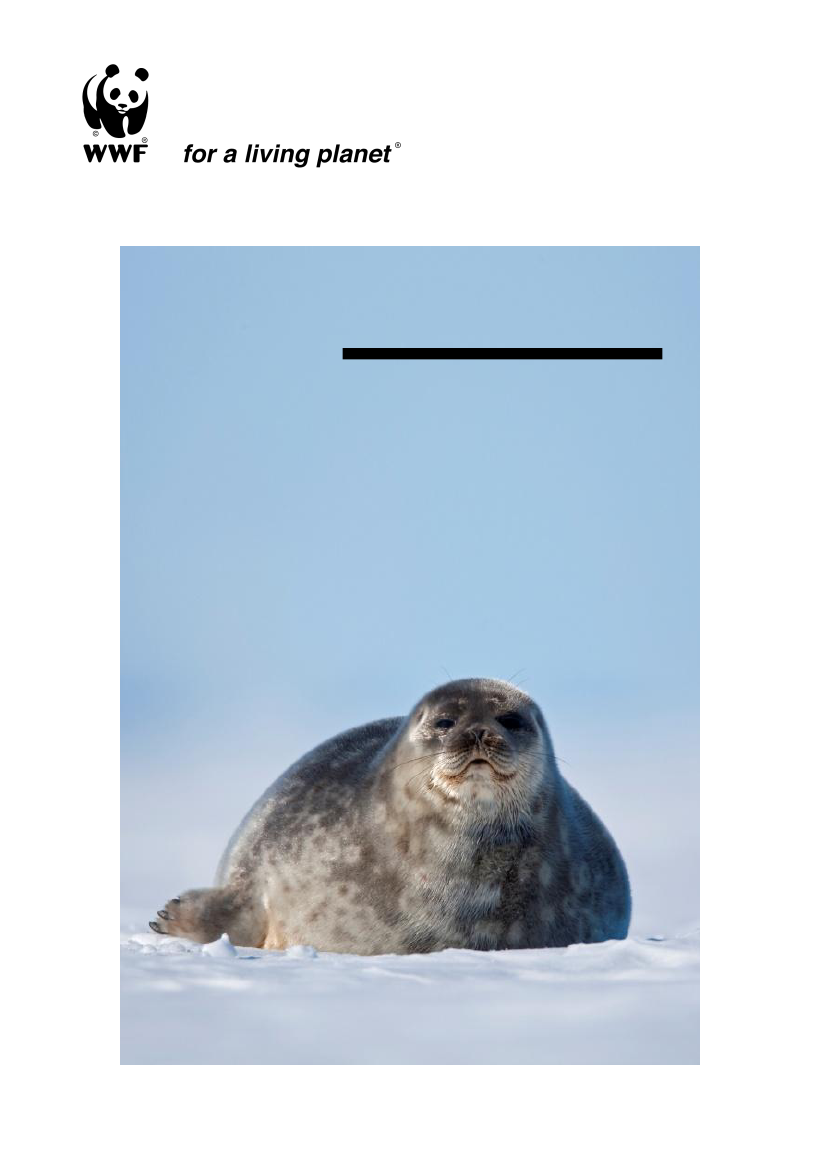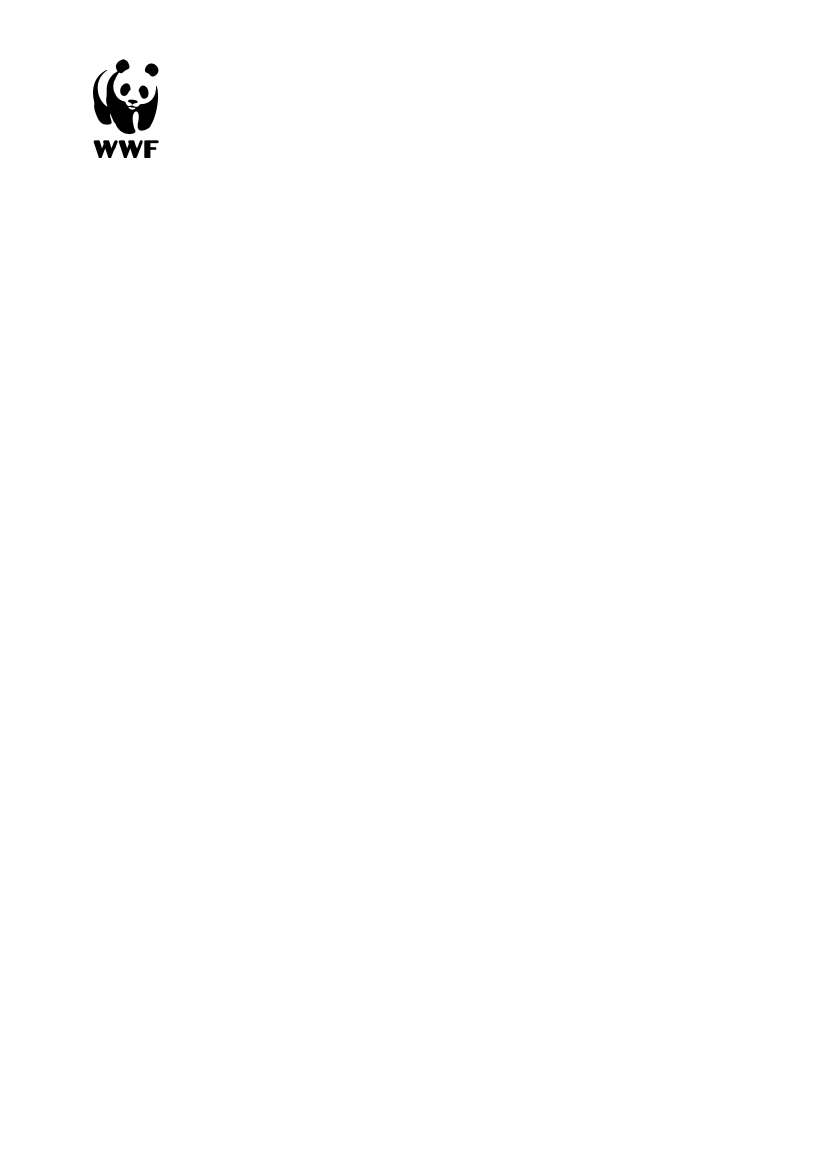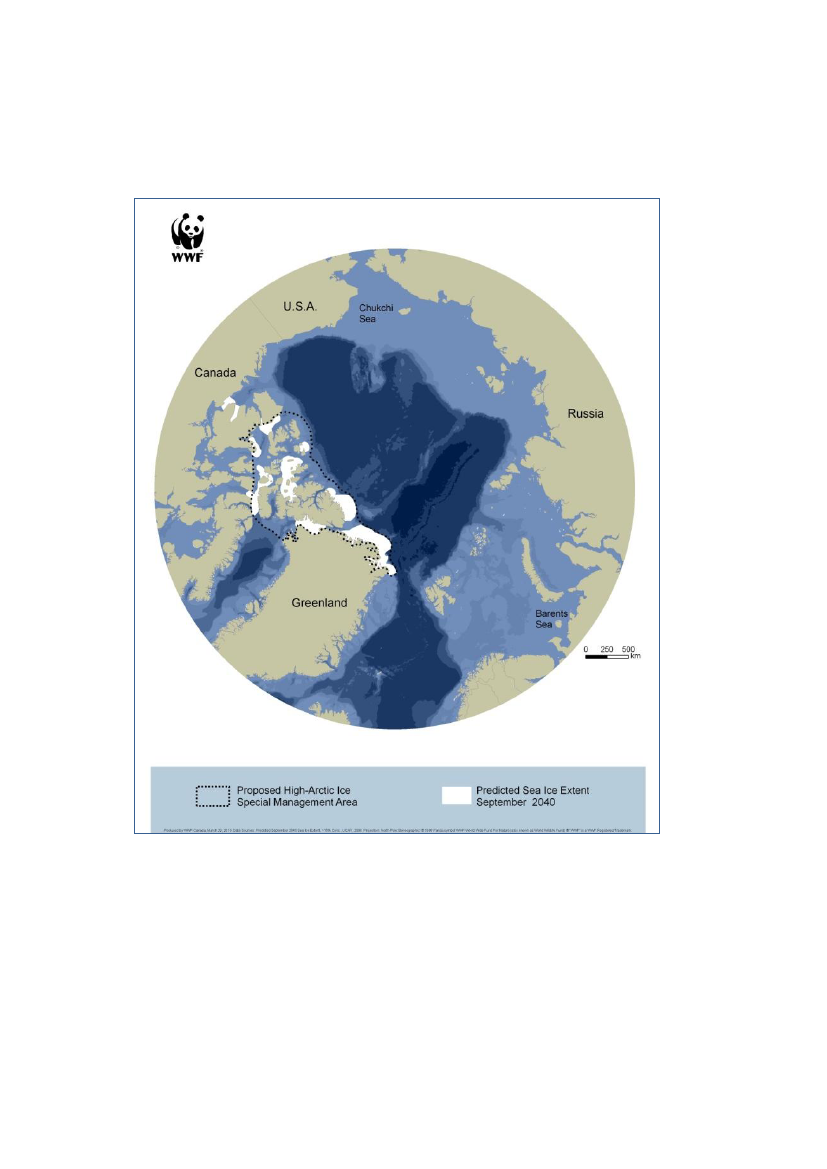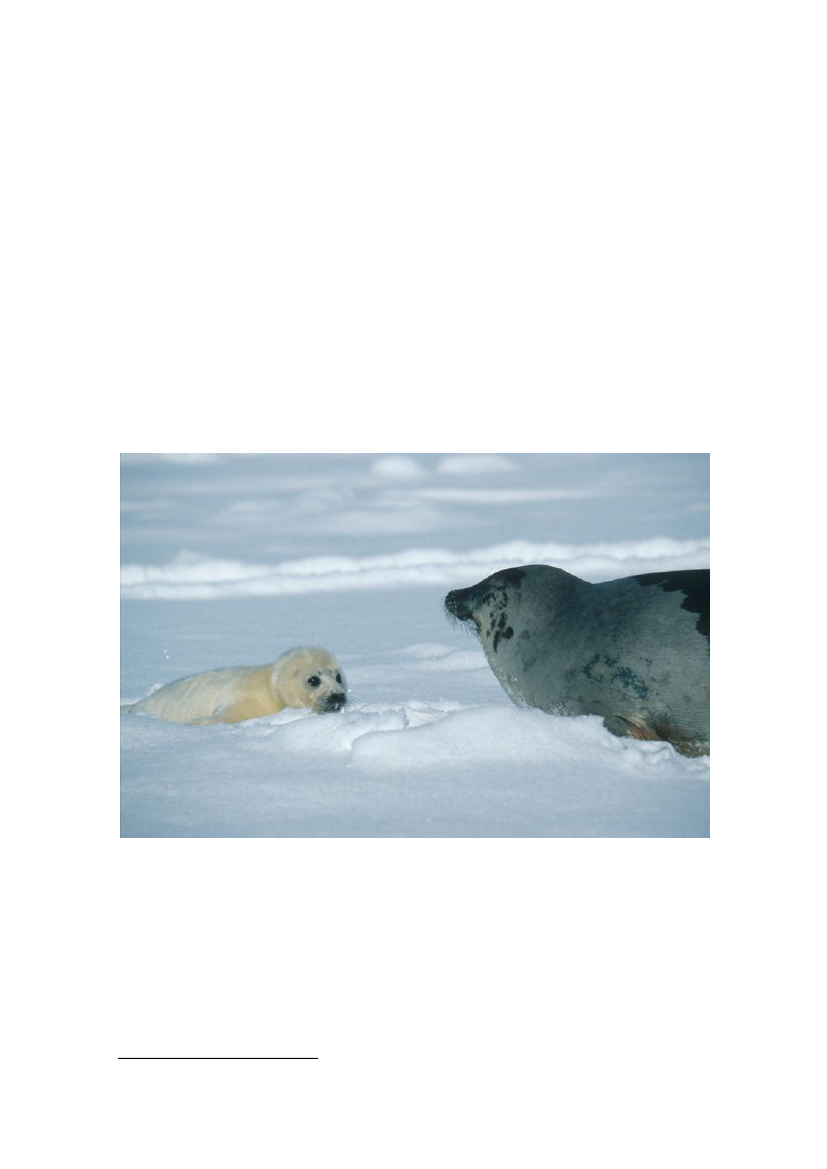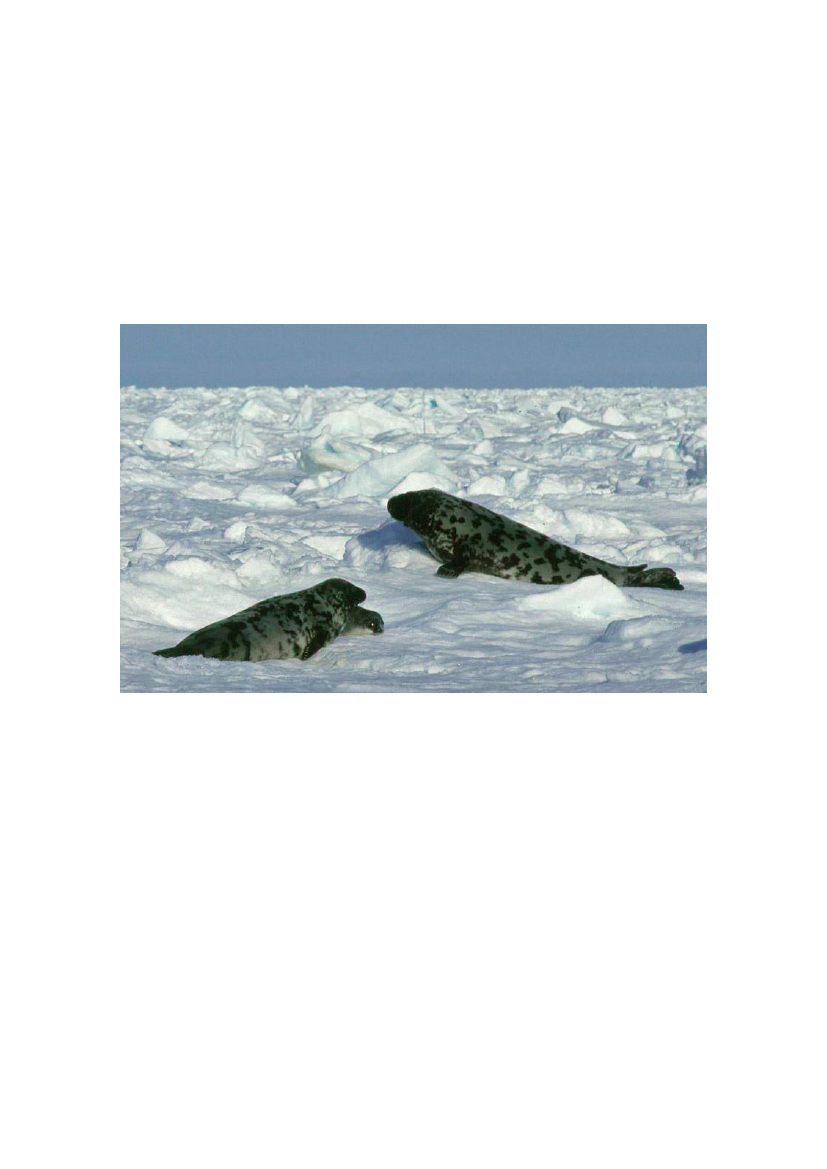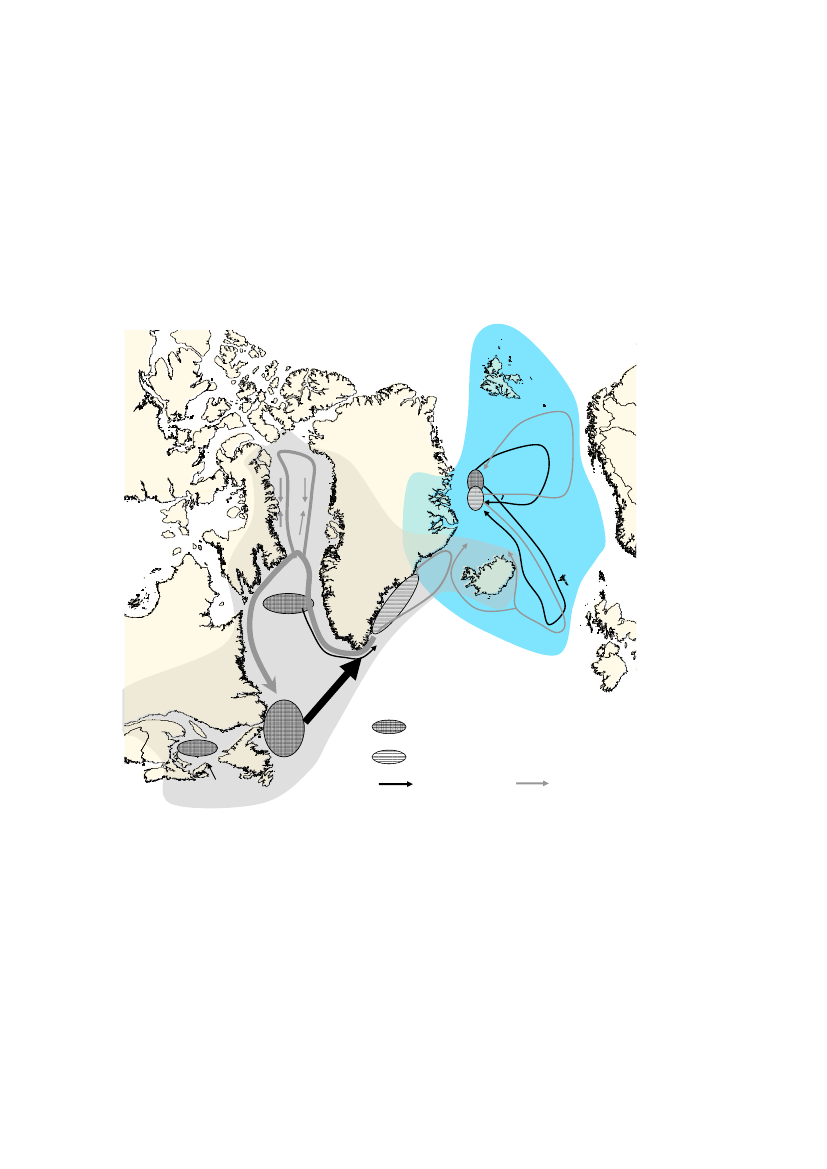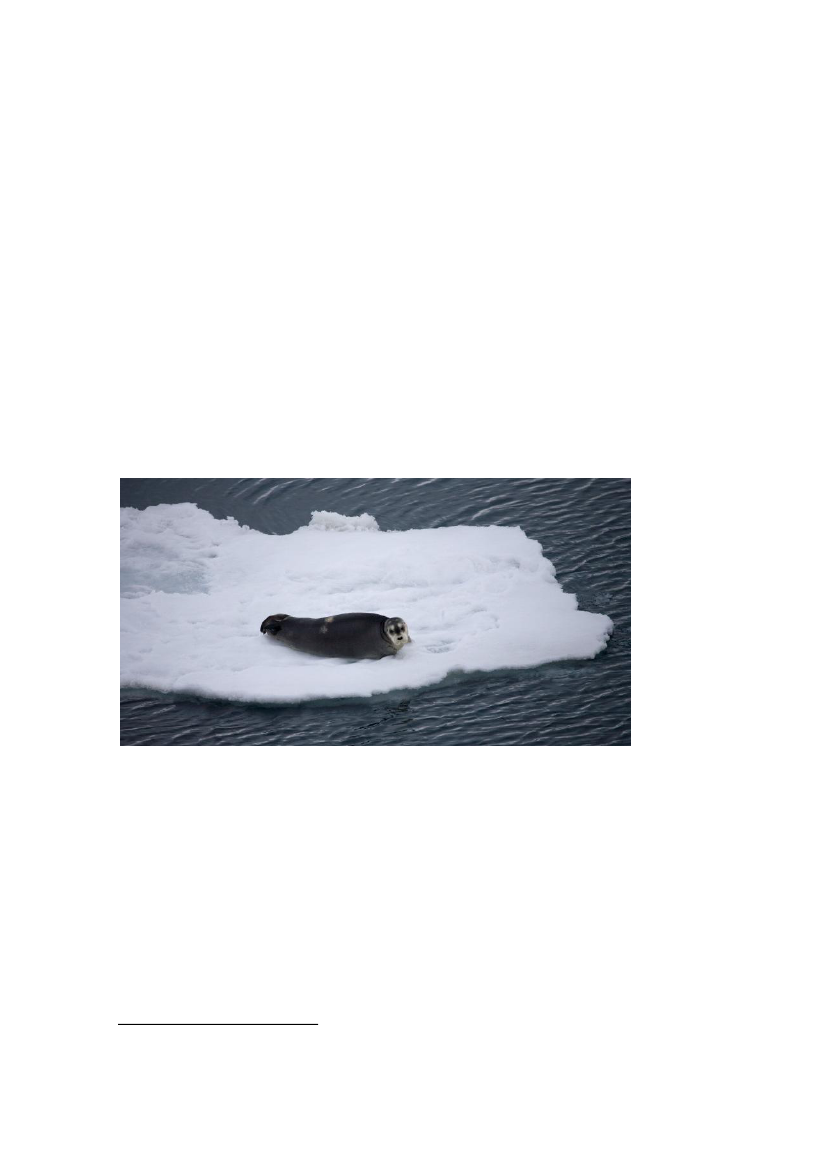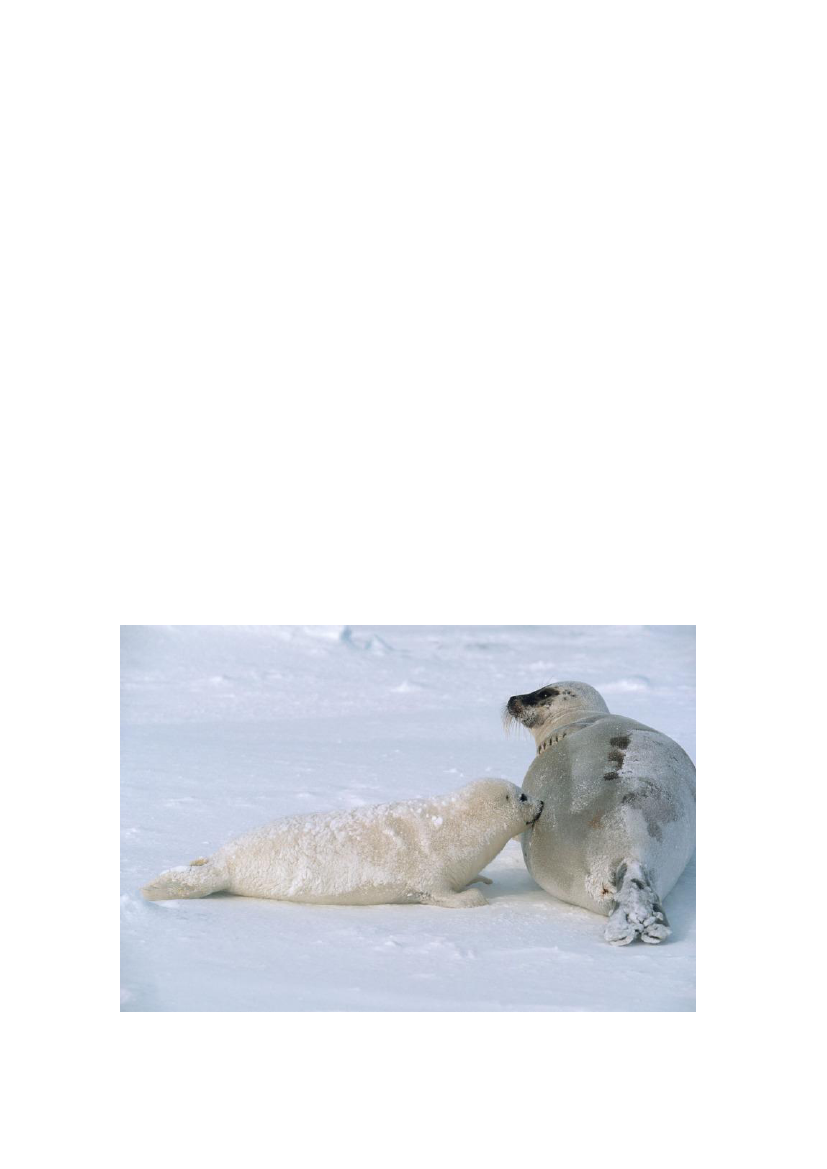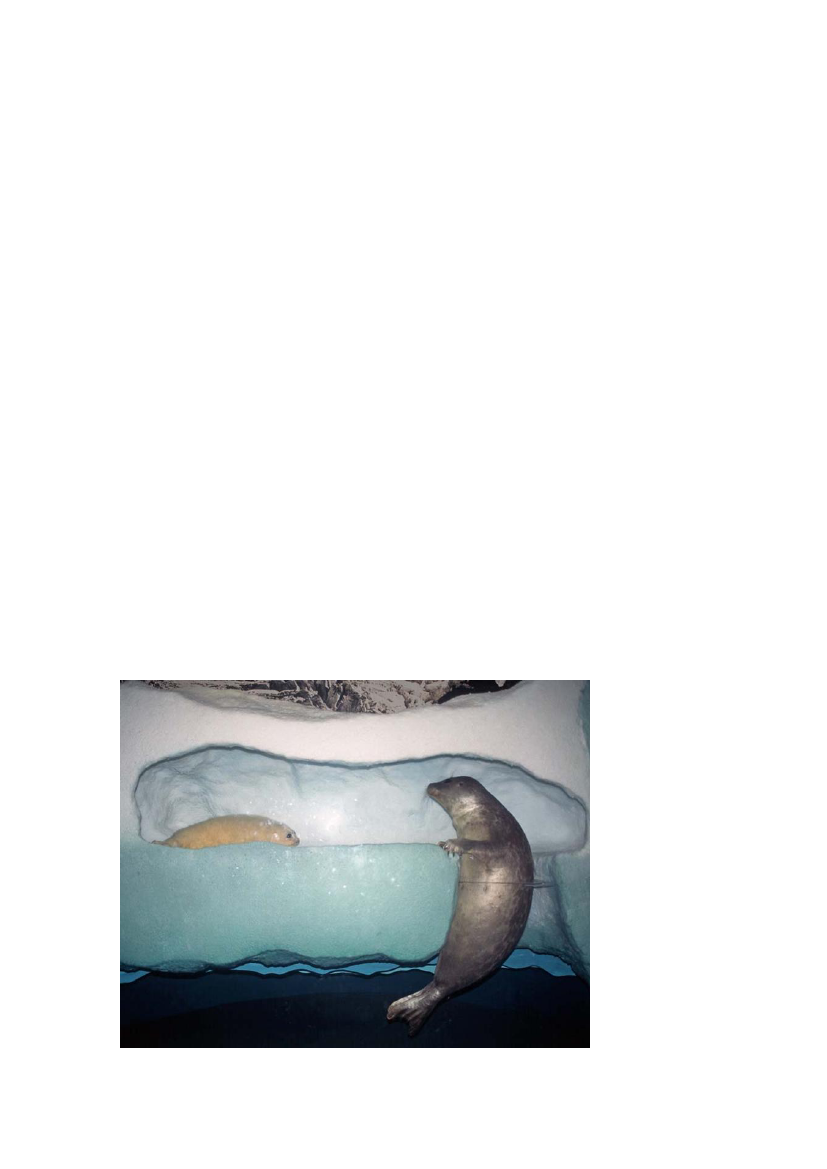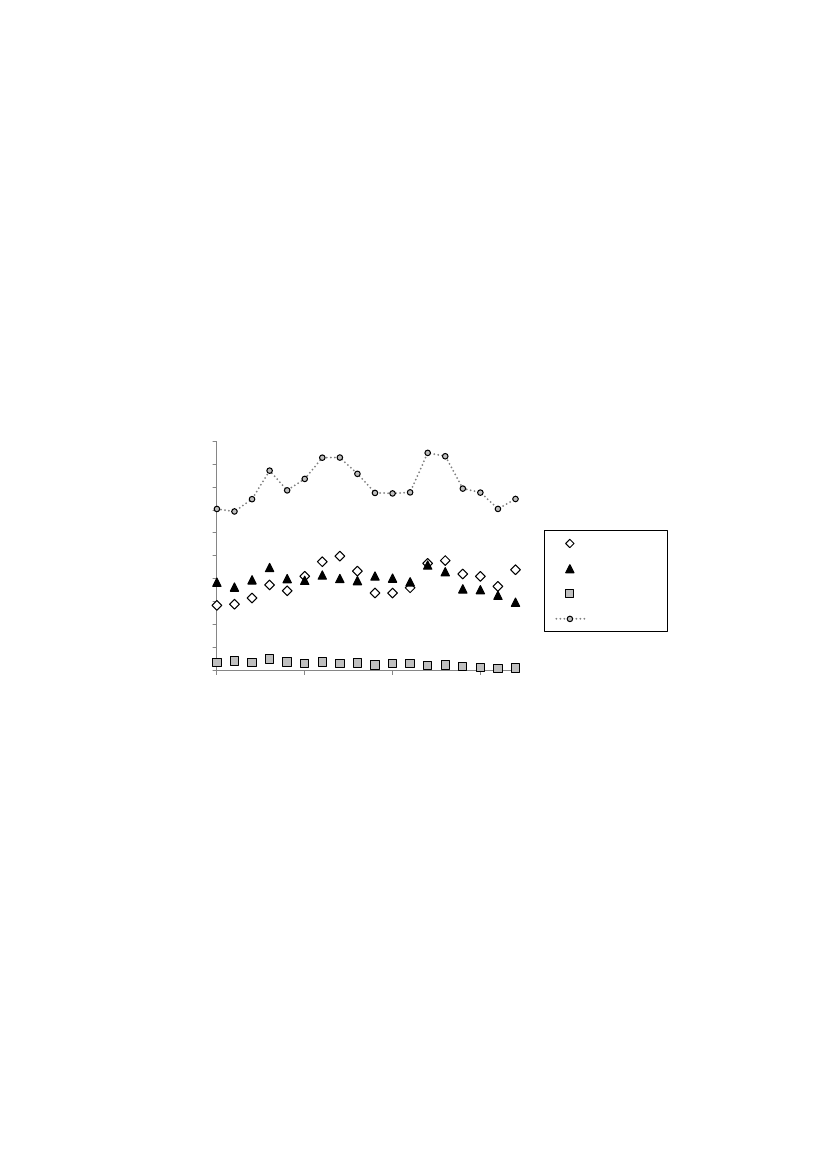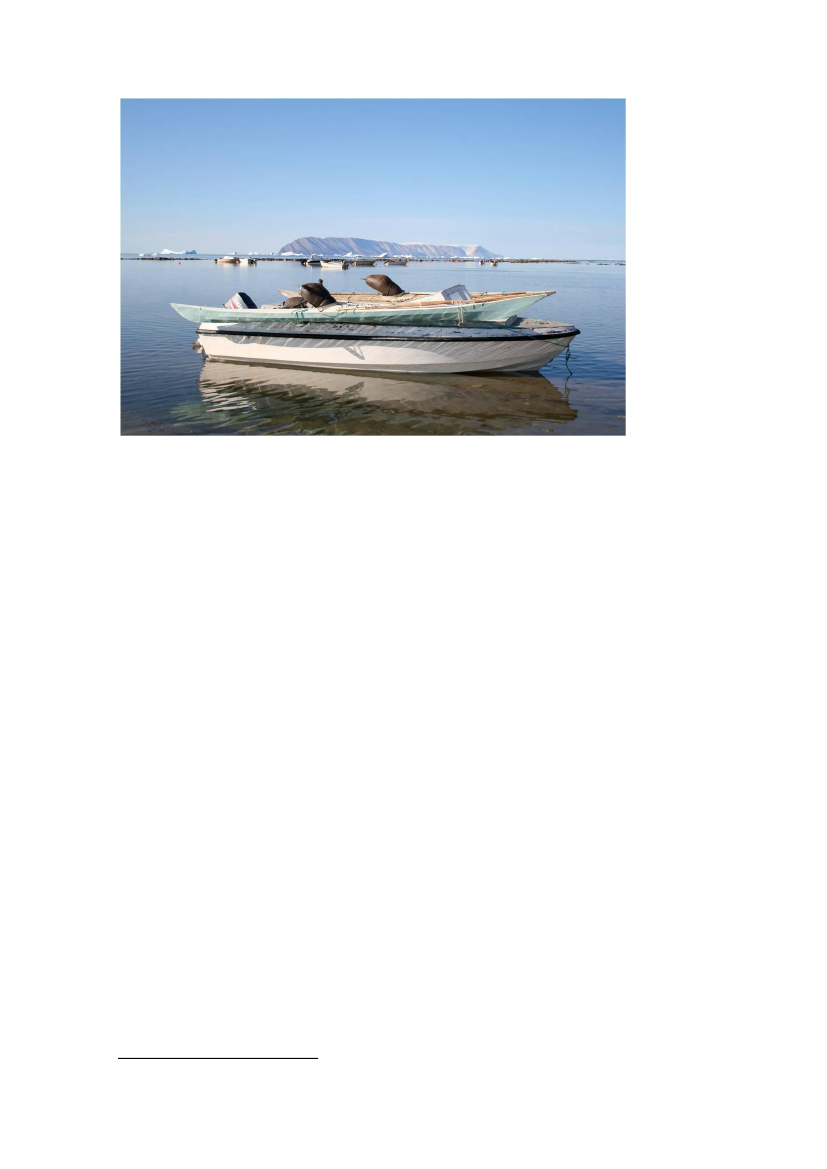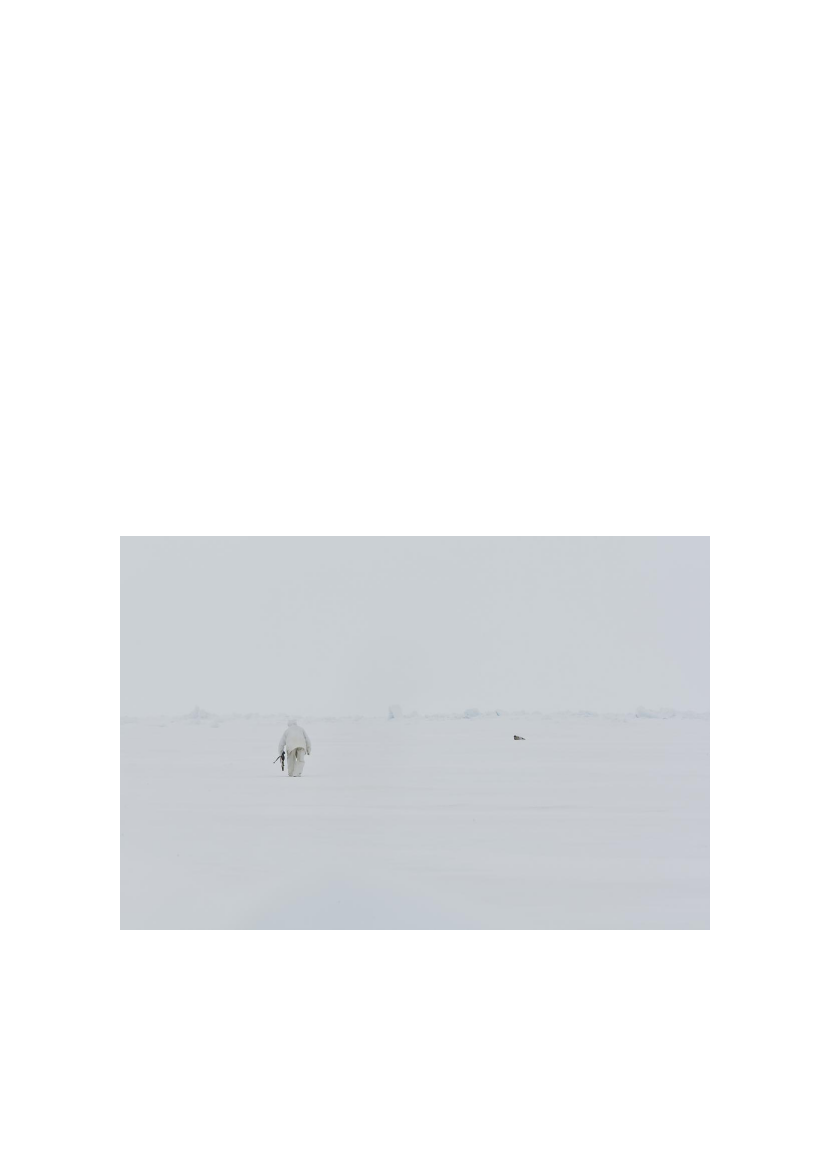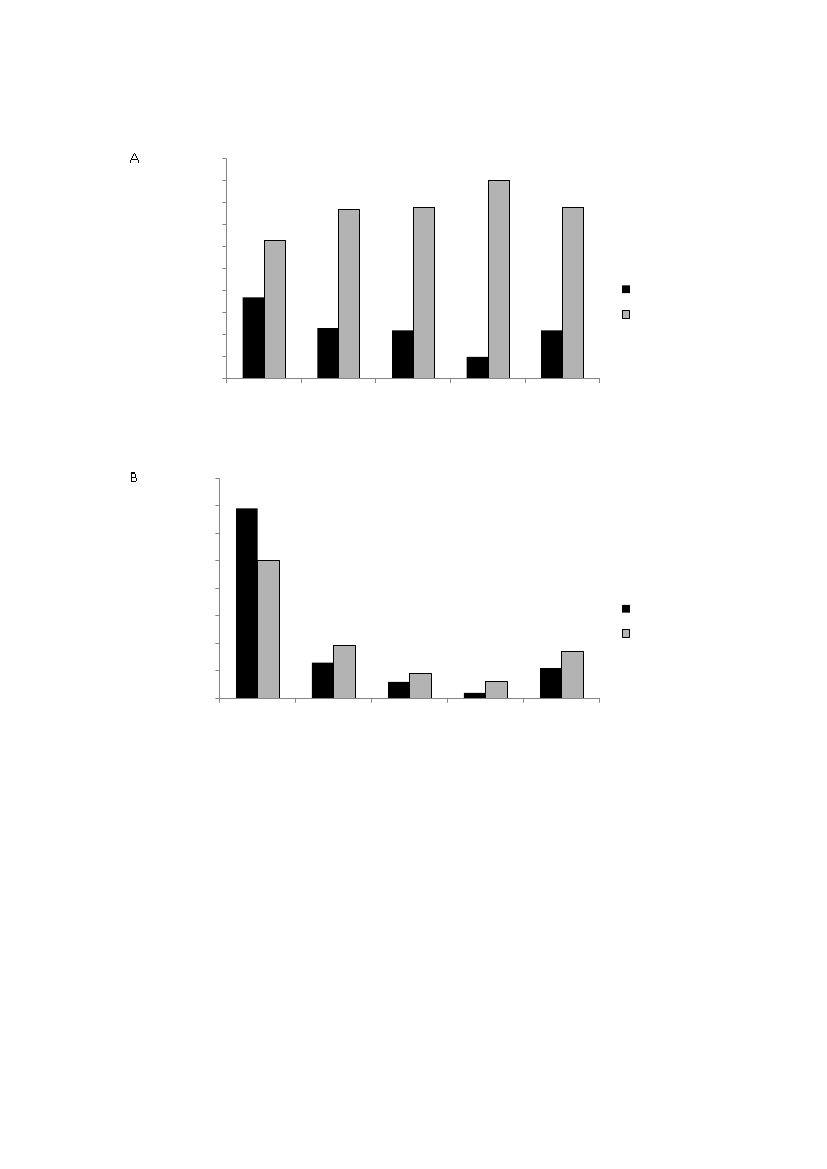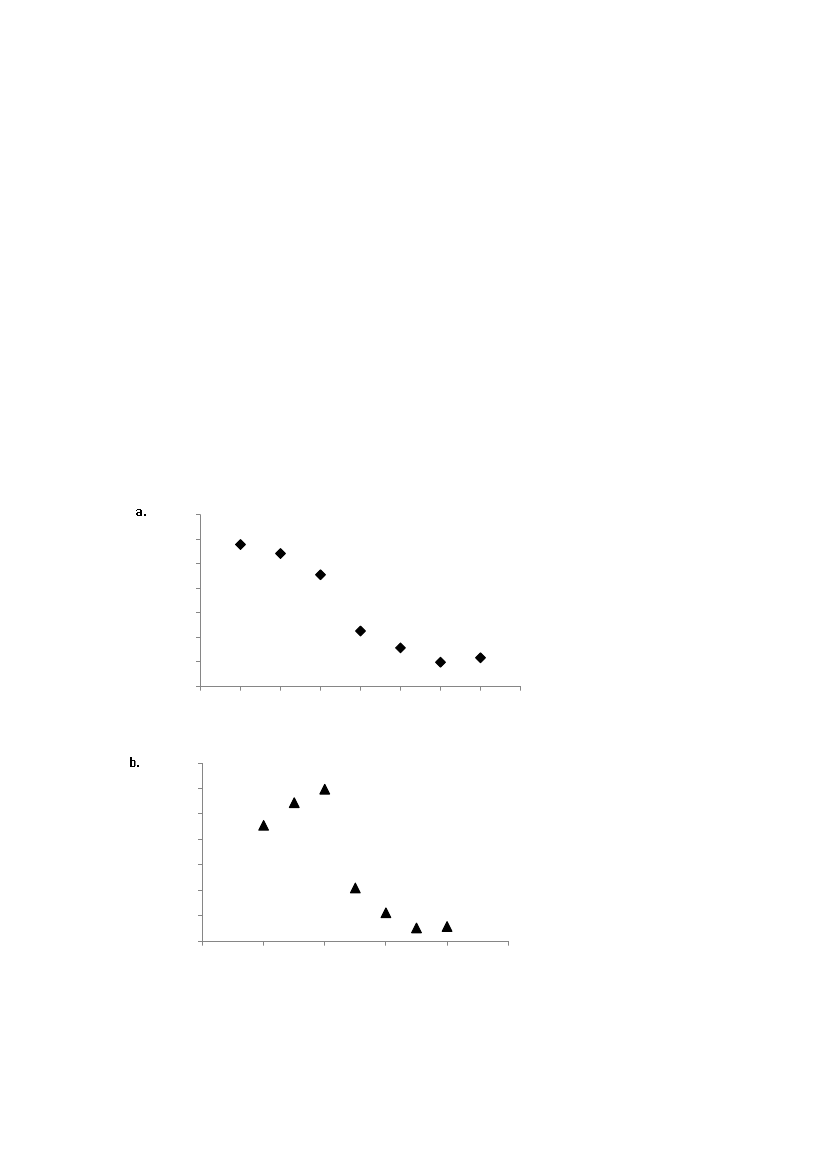Grønlandsudvalget 2013-14
GRU Alm.del Bilag 25
Offentligt
Seals in Greenland----
- An important component of cultureand economyThe Last Ice Area Project
December 2013
ReportSeals in Greenland: - An important component of culture and economy.The Last Ice Area Project.Published byWWF Verdensnaturfonden, Svanevej 12, 2400 København NV.Telefon: +45 35 36 36 35 – E-mail: [email protected]ProjectThis report is part of the WWF project the Last Ice Area.Front page photoRinged seal on sea ice, Scoresbysund//Ittoqqortoormiit, East Greenland.� Carsten Egevang / ARC-PIC.COM.The AuthorEva Garde is a biologist. She has a PhD in narwhal population biology from the University ofCopenhagen, Denmark, and the Greenland Institute of Natural Resources, Greenland.Comments to the report from:KNAPK has commented on the report.The Greenland Institute of Natural Resources has commented on the first chapter ‘TheGreenlandic seals’.This report can be downloaded from:WWF: www.wwf.dk/arktis
Table of ContentThe Last Ice Area ........................................................................................................................... 2Ilisarititsineq .................................................................................................................................. 3Last Ice Area/Den Sidste Is ............................................................................................................ 4Foreword ....................................................................................................................................... 6English abstract ............................................................................................................................. 7Eqikkagaq ...................................................................................................................................... 8Resumé ........................................................................................................................................ 101.The Greenlandic seals ......................................................................................................... 12The harp seal ........................................................................................................................... 13The ringed seal ........................................................................................................................ 15The hooded seal ...................................................................................................................... 17The bearded, harbor, and grey seals....................................................................................... 19Seals on the Red List................................................................................................................ 202.3.Seals in a changing world .................................................................................................... 22Seals as a hunted resource .................................................................................................. 25Seal management.................................................................................................................... 25The Greenlandic seal harvest – in numbers ............................................................................ 26Greenlandic hunters – in numbers.......................................................................................... 27How to hunt a seal in Greenland… .......................................................................................... 304.5.6.The fall of an ancient profession ......................................................................................... 34Inuit Sila - the Greenlandic pro-sealing campaign .................................................................. 35Banning the seals ................................................................................................................ 38Summary: Seals ahead…...................................................................................................... 41Recommendations .................................................................................................................. 41References................................................................................................................................... 43
1
The Last Ice AreaThis is one of a series of research resources commissioned by WWF to help inform futuremanagement of the area we call “the Last Ice Area”. We call it that because the title refersto the area of summer sea ice in the Arctic that is projected to last. As climate change eatsaway at the rest of the Arctic’s summer sea ice, climate and ice modelers believe that theice will remain above Canada’s High Arctic Islands, and above Northern Greenland formany more decades.Much life has evolved together with the ice. Creatures from tiny single celled animals toseals and walrus, polar bears and whales, depend to some extent on the presence of ice.This means the areas where sea ice remains may become very important to this ice-adapted life in the future. One of my colleagues suggested we should have called theproject theLastingIce Area. I agree, although it’s a bit late to change the name now, thatname better conveys what we want to talk about. While much is changing, and is likely tochange around the Arctic, this is the place that is likely to change the least. That is alsomeaningful for the people who live around the fringes of this area – while people in otherparts of the Arctic may be forced to change and adapt as summer sea ice shrinks, thepeople around the Last Ice Area may not have to change as much.As a conservation organization, WWF does not oppose all change. Our goal is to helpmaintain important parts of the natural world. These parts are important in their ownright, and they are important for people. WWF does not have the power and authority toimpose its vision on people. Instead, we try to present evidence through research, andoptions for management action. It is then up to the relevant authorities as to whether theywill take action or not; the communities, the Inuit organizations, and the governments ofthe Last Ice Area will decide its future fate. We hope you will find the information in thisreport useful, and that it will help you in making wise decisions about the future of theLast Ice Area.
Clive Tesar, WWF Global Arctic Programme. Last Ice Area lead.
2
IlisarititsineqSiunissamiLast Ice Area-mik(LIA) taagugaq – imaluunniit Siku Kingulleq pillugumisissuinissap nakkutigineqarnissaanut ikorfartuiniarluni misissuinerit ilaattut misissuinequna WWF-ip aallartippaa. Issittup imartaa aasaanerani sikuuinnartartoq, sivisunerpaamikaannikuunngitsoq misissuinerup taaguuteqaatigaa. Issittup imartaa aasaaneranisikuuinnartartoq silap pissusaata allanngoriartornera peqqutigalugumilliartuinnaraluartoq, sikumik silallu pissusaata allanngoriartorneranik misissuineritnaapertorlugit, qeqertat Canadap avannnaata kangianittut kiisalu Kalaallit Nunaataavannaata avataat suli ukiuni qulikkaani arlalinni sikuuinnarallassapput.Siku uumassusillit minnersaanniit puisinut, aarrinut, nannunut arfernulluineriartorfiusimalluni, siku tamanna arlalinnit pinngitsoorneqarsinnaanngilaq. Sumiiffiit sulisikusartut uumasunut sikup sinaanut naleqqussarsimasunut siunissamipingaaruteqartupilussuussaaq. Suleqatima siunnersuutigingaluarpaa sumiiffik tamannaatsissagipputLasting Ice Area– Siku aajuitsoq. Uanga isumaqataavunga. Atsernissaanutkingusinaareeraluarluta, samminiagarput taamatut paasiuminarsarneqarsinnaavoq.Issittumi sorpassuit allanngoriartorput sulilu allat aamma allanngoriartulissagunarlutik,sumiiffilli tamanna allanngujuinnerpaassagunarpoq. Sumiiffimmi aamma inunnut sikupsinaani najugalinnut tamanna pingaaruteqarpoq. Issittumi sumiiffinni allani aasaaneranisikuuinnartartup milliartornera ilutigalugu inuit noorarlutik allaminaleqqussartussaassasut, maani Siku Aajuitsup eqqaani najugallit inuunerminnikallannguingaartariaqassanngillat.WWF pinngortitamik avatangiisinillu illersuiniaqatigiiffittut pissutsinut allanngortunutakerliuniartuunngilaq. Pinngortitap, minnerunngitsumik inunnik najugaqartunitpingaartinneqartup illersornissaanik eriagisaanissaanillu suliaqartuuvugut. Inuit allat uaguttakorluukkatsinnik sunnerniarnissaanut WWF-imi pissaaneqaratalu pisussaaffeqanngilagut.Isummagulli ilisimatusarnikkut periusissanillu saqqummiisarnikkutuppernarsaaserniartarlutigit. Tamanna pereeraangat periuseqartoqassanersoqiliuuseqartoqassannginnersorluunniit taava oqartussat namminneqaalajangertussaasarpaat. Sumiiffimmi Siku Kingulliup inissisimaffiani najugallit, kattuffiitkiisalu oqartussat tamaani qanoq iliuuseqartoqassanersoq aalajangissavaat. Neriuppugutnalunaarusiaq iluaqutigisinnaassagissi, siunissamilu Siku Kingulleq pilluguaalajangiinissassinnut ikiuutaalluarumaartoq.Clive Tesar, WWF Global Arctic Programme. Projektleder Last Ice Area.
3
Last Ice Area/Den Sidste IsDette studie er et i en række af studier, som WWF har igangsat med det formål at biståfremtidige forvaltninger af det område, som vi kalder Last Ice Area/Den Sidste Is. Navnetrefererer til det område med sommerhavis i Arktis, som beregnes til at bestå længst. I taktmed at klimaforandringerne tærer på den resterende sommerhavis i Arktis, forudser is- ogklimaberegninger, at denne is fortsat vil eksistere over Canadas nordøstlige øer og overNordgrønland i mange årtier endnu.Meget liv har udviklet sig sammen med isen. Fra de mindste encellede organismer tilsæler, hvalrosser, isbjørne og hvaler er en hel række skabninger afhængige aftilstedeværelsen af denne is. I fremtiden kan de områder, hvor der stadig findes havis,blive meget vigtige for de dyr, der er tilpasset et liv ved isen. En af mine kolleger foreslog,at vi skulle have kaldt området Lasting Ice Area/Den Blivende Is. Selvom det er for sent atændre navnet nu, så giver jeg ham ret i at denne titel bedre ville formidle det vi ønsker attale om. Mens meget er under forandring og sandsynligvis vil ændre sig i Arktis, er detteområde det, der formentlig vil ændre sig mindst. Det har også stor betydning for demennesker, der bor i udkanten af dette område. Mens folk i andre områder af Arktis kanblive tvunget til at ændre og tilpasse sig, i tråd med at sommerhavisen bliver mindre,behøver de mennesker, der lever ved Den Sidste Is måske ikke at ændre deres livsform såmeget.WWF er en natur- og miljøbeskyttelsesorganisation der ikke modsætter sig al forandring.Vi arbejder for at beskytte og bevare natur, og især den natur der er vigtig simpelthenfordi den findes og fordi den er vigtig for mennesker der. WWF har hverken indflydelseeller mandat til at pålægge andre vores vision. I stedet forsøger vi at dokumentere voresholdninger gennem forskning og ved at fremlægge handlingsmuligheder. Det er herefterop til de relevante myndigheder om de vil handle eller ej: lokalsamfund, organisationerneog regeringerne i det område, hvor vi finder Last Ice Area/Den Sidste Is, vil afgøreområdets fremtidige skæbne. Vi håber, at I vil finde rapporten nyttig, og at den vil hjælpetil med at træffe gode beslutninger om fremtiden for Last Ice Area/Den Sidste Is.
Clive Tesar, WWF Global Arctic Programme. Projektleder Last Ice Area.
4
The dotted line shows the Greenland Last Ice Area. The area includes marine, coastal, andterrestrial regions as well as the Greenland Ice Sheet. There is one town (Qaanaaq), andthree settlements (Savissivik, Qeqertat and Siorapaluk) located within the Greenlandicpart of the Last Ice Area.
5
ForewordSeals are fundamental pieces in the puzzle called Arctic ecology. They fill out a significantrole in the ice cold habitats on top of the world, and as such they are essential andirreplaceable as most other species inhabiting these pristine regions. But the seals are alsoa hunted resource – as they have been for as long as man has lived in the Arctic regions.Today, as in the past, the majority of people in Greenland live in close connection to thesea and the Arctic nature. They engage in hunting and fishing activities on a regular ordaily basis that sustain them and contribute to their income. The traditional way of life ofhunting and fishing is thus intertwined with a modern society and economics. But there ismore to hunting and fishing than earning money. It is a lifestyle, a culture, a tradition, andit provides local food for the inhabitants in Greenland – hence the seals remain to be animportant part of everyday life here.This report focuses on seals in Greenland, their biology, their dependence on sea ice andthe impacts of climate change on seals in the North Atlantic. We place special emphasis onthree seal species that are found in the Last Ice Area which are also the most importantfrom a cultural and socioeconomic perspective in Greenland. In words and numbers, wedescribe the Greenlandic hunt on seals and the negative impacts that the European Unionimport bans on seal products have had on the Greenlandic hunters and the sealskinbusiness in Greenland.The purpose of the report is to provide insightful and useful information for its readereither as an information source on seals and seal hunting in Greenland or to facilitatedecision-making regarding the Last Ice Area.
Gitte Seeberg, CEO WWF Denmark
6
English abstractWithin Greenland waters six species of true (or earless) seals can be found. In this reportwe will describe these six species with emphasis on three ‘ice-seals’; the harp seal (Phocagroenlandica),the ringed seal (Pusahispida)and the hooded seal (Cystophoracristata).These three species are dependent on sea-ice for e.g. reproduction, and they are all foundin the Greenland Last Ice Area. They are also essential from a cultural and socioeconomicperspective where they continue to be an important part of the Inuit way of life in all ofGreenland.The harp seal and the ringed seal are the most abundant of the Greenlandic sealswith population estimates in the millions, whereas the hooded seal populations estimate ismore than half a million individuals. The status of all three species is ofLeast Concernaccording to the Greenland Red List. Although these species are numerous and in generalthe populations are thriving (however this does not apply for the decreasing NortheastAtlantic stock of hooded seals), the seals are living in areas where the impacts of climatechange are progressing. And the ice-seals will at least to some degree be challenged by theeffects of climate change, although the extent is difficult to predict.In Greenland, as in most other Arctic areas, humans have utilized seals for food,clothes and revenue, and as such the seals are and have been for centuries maybethemost vital resource in these often very remotely located communities. The hunt of seals inGreenland is as large as ever with approximately 150,000 animals being caught a year. Thishunt is managed by the Government of Greenland based on advice from internationalorganizations, and is regarded as biologically sustainable. Roughly 7,000 Greenlandershave a hunting license (12 % of the total human population in Greenland). Of these,approximately 2,000 have a full time hunting license and 5000 are leisure hunters.In the Last Ice Area one town and three settlements are located. Here, hunting is themain occupation, and nearly 20 % of the human population (less than 800 people) has ahunting license. Important prey species include seals (ringed seal in particular), belugawhales and narwhals. In Greenland four hunting methods are used for hunting seal.The seal hunt and the sealskin business in Greenland has been challenged over thepast four decades, first by anti-sealing campaigns in the 1970s and 1980s directed againstthe Canadian harvest of harp seal pups, and later by the European Union’s (EU) importbans on seal products. Although the European bans exempted the Inuit subsistence huntof seals, the bans have resulted in dramatic dives in sales of sealskin from Greenland andhunters, their families and the business are severely affected. Stakeholders want the EU toinform its citizens about the Inuit exemption as a way to reverse the trend positively.WWF supports the sustainable Inuit hunt of seals in Greenland and call for the EU toaddress the impacts of their import bans as well as to act in response by informing theEuropean public about the Inuit exemption. With support from the EU, the existingcertification label could considered expanded to guarantee e.g. sustainability of the hunt, fullutilization of catches and animal welfareto meet increasing demands from consciousconsumers in the EU as well as worldwide.
7
EqikkagaqKalaallit nunaanni puisiviit artit arfiniliupput. Uani taakkua artit arfinillit allaaserivagut,puisit sikumiittartut pingasut pingaartinnerullugit, tassaasut; aataaq (PhocaGroenlandica),natseq (Pusahispida)kiisalu natsersuaq (Cystophoracristata).Artit taakkua pingasuttamarmik siku pisariaqartippaat soorlu piaqqiornissaminnut, tamarmillu WWF-ipsulinermini Last Ice Area/Sikoqarfik Kingullermik taagugaata ilaani Kalaallit Nunaannutkilleqarfiup iluani siumugassaallutik. Puisit suli kalaallit inooriaasaannut ileqqutoqaannullupingaaruteqarput taamatullu kulturimut inuiaqatigiillu aningaasaqarnerannutpingaaruteqarluinnarlutik.Kalaallit Nunaata imartaani Aataat natserillu amerlanersaallutik miliuuninik arlalinnikamerlassuseqarput, natsersuit miliuunip affaanik amerlassusillit. Kalaallit Nunaanniuumasut nungunnissaminnut aarlerigineqartut allassimaffiat naapertorlugu artit taakkuapingasutLeast Concern/aarlerinartorsiunngillat.Puisit tamakkua amerlagaluarlutilluiluarusukkaluarlutik (Natsersuilli atlatikup avannaata kangianiittut ikiliartoramik taamatutnaliliiffigineqanngilat), sumiiffinni silap pissusaata allanngoriartorneraniksunnerneqariartuinnartuni uumasuupput. Silap pissusaata allanngoriartorneratasunniutissai suli siumut eqqoriaruminaakkaluartut, puisit sikumiittartutsunnerneqarnermikkut unammilligaqanngitsoornavianngillat.Issittumi sumiiffinni amerlanerpaani allanitulli Kalaallit Nunaanni inuitnerisaqarniarlutik, atisassaqarniarlutik isertitaqarniarlutillu puisinikisumalluuteqarnikuupput, ukiunilu hunnorujukkaani ilaatigut sumiiffinniavinngarusimaqisuni najugalinnit pingaaruteqaqisumik isumalluutigineqarnikuullutik.Kalaallit Nunaanni maannakkut aatsaat taama puisinik pisaqartoqartartigaluni ukiumutpuisit 150.000-it missaanniittut pisarineqartarput. Kalaallit Nunaanni Naalakkersuisutkattuffinnit nunanit tamaneersunit siunnersorneqartarlutik puisittanik nakkutilliisuupput.Kalaallit 7.000-it missaanniittut piniarnissaminnut akuersissummik allagartaqarput, tassakalaallit inuiaqatigiit tamarmik 12 procentii. Taakkua 7.000-it akornanni 2.000-itpiniarnermik inuussutissarsiutilittut kiisalu 5.000-it sunngiffimminni piniartartututallagartaqarput.Sumiiffiup Last Ice Area/Sikoqarfik Kingulliup iluani sisamanik nunaqarfeqarpoq.Taakkunani piniarneq inuussutissarsiutit annersaraat, tamaanilu najugallit tamarmik 800-tinorlugit amerlassusillit 20 procentingajaat piniarnissaminnut allagartaqarput. Puisit(annerusumik natserit), qilalukkat qaqortat (Delphinapterusleucas)kiisalu qilalukkatqernertat (Monodonmonoceros)pingaarnerusutut piniagarineqarput. Puisinniariaatsitsisamat Kalaallit Nunaanni atorneqarput.Kalaallit Nunaanni puisinniarneq puisillu amiinik tunisassiorneq ukiuni qulikkaanisisamani kingullerni arlaleriarlutik annertuunik unammilligassaqartsinneqartarnikuupput.Siullermik 1970-ikkunni 1980-ikkunnilu puisinniarnermik akerliusut paasititsiniaasarnerinit,annerusumik Canadami aataat piaraannik piniarnermut sammisunit, kingusinnerusukkulluEuropami Naalagaaffiit Kattuffiata (EU) puisit amiinik taakkungannalu tunisassianikEuropamut eqqusseqqusiunnaarnerannit. Naak Kalaallit Nunaanni nunap inoqqaavisapuisittaasa amii europamiut eqqusseqqusiunnaarnerminnut ilanngutinngikkaluaraat,8
taamatut inerteqquteqalernerup kinguneranik kalaallit puisittaasa amiisanioqqutigineqarnerat apparujussuarnikuuvoq, taamaalillutillu piniartut, taakkua ilaqutaatkiisalu puisit amiinik tunisassiorfiit annertuumik eqqorneqarlutik. EU-pinerteqquteqarnermini naggueqatigiit Inuit pisaasa pineqannginnerat, innuttaasunut EU-ppaasititsissutiginiassagaa, tamatumannga soqutigisallit, soorlu kalaallit piniartortaasa,Kalaallit Nunaanni Naalakkersuisuisa kiisalu amernik tunisassiorfiit kaammattuutigaat,taamaalilluni eqquinerlunneq aaqqiissutissiiffiginiaqqullugu.Kalaallit Nunaanni nungusaataanngitsumik puisinniarneq WWF-ip tapersersorpaa,EU-llu inerteqqusiinermi sunniutai erseqqissarlugit kiisalu naggueqatigiit Inuitinerteqqusiinermi pineqannginnerat EU-mi innuttaasunut paasissutissiissutigissagaikaammattutigaa. EU-mi nunarsuattalu sinnerani pisisartut pissutsit pillugit ilisimasatiknaapertorlugit annertusiartuinnartunik piumasaqaateqartalernerat pissutigalugu, EU-ptapiissuteqarneratigut piniarnissamut akuersissuteqartarnermi piumasaqaatit allat, soorlunungusaataanngitsumik piniarnissap, pisap tamarmi atorluarneqarnissaata kiisaluuumasunik naalliutsitsinnginnissap piumasaqaatigisalernissaasaqularnaarneqarsinnaanerat eqqarsaatigineqarsinnaavoq.
9
ResuméI Grønland findes seks arter af ægte (eller øreløse) sæler. Her beskriver vi disse seks arter,med hovedvægt på tre ’is-sæler’; grønlandssælen (PhocaGroenlandica),ringsælen (Pusahispida)og klapmydsen (Cystophoracristata).Disse tre arter er alle afhængige af havisentil for eksempel reproduktion, og de er alle at finde i den grønlandske del af det område,som WWF arbejder med under navnet Last Ice Area/Den Sidste is. Sælerne er ogsåafgørende set fra et kulturelt og samfundsøkonomisk perspektiv, hvor de fortsat er envigtig del af den grønlandske livsførelse og tradition.Grønlandssælen og ringsælen er de mest talrige af de grønlandske sæler medpopulationer, der tæller flere millioner individer, mens den samlede klapmyds-bestand erpå mere end en halv million sæler. Status for alle tre arter erLeast Concern/Ikke truedeihenhold til den grønlandske rødliste. Men selvom disse sælarter er talrige og generelttrives (gælder dog ikke for den Nordøstatlantiske bestand af klapmyds, som er fornedadgående), så lever sælerne i områder, hvor virkningerne af klimaændringerne erfremskredne. Og is-sælerne vil, i hvert fald til en vis grad, blive udfordret afklimaændringerne, selv om det er vanskeligt at forudsige konsekvensernes omfang.I Grønland, som i de fleste andre arktiske områder, har mennesket udnyttet sæler tilat skaffe mad, tøj, og indtægter og som sådan er og har sælerne i århundreder været dennok mest afgørende ressource i disse ofte fjernt beliggende samfund. Fangsten af sæler iGrønland er i øjeblikket større end nogensinde før med omkring 150.000 nedlagte dyr omåret. Fangsten administreres af den grønlandske regering som modtager rådgivning frainternationale organisationer. Cirka 7.000 grønlændere har i dag et jagttegn, hvilket svarertil 12 % af den samlede grønlandske befolkning. Af disse 7.000 har cirka 2.000 etfuldtidsjagttegn og 5.000 er fritidsfangere.Indenfor området Last Ice Area/Den Sidste Is findes fire bygder. Her er fangsthovederhvervet, og næsten 20 % af områdets samlede befolkning på mindre end 800personer, har et jagttegn. Vigtige fangstdyr inkluderer bl.a. sæler (ringsæl i særdeleshed),hvidhvaler og narhvaler. Fire jagtmetoder bliver brugt til at fange sæler i Grønland.Sælfangsten og sælskindsindustrien i Grønland er i løbet af de seneste fire årtierblevet kraftigt udfordret af flere omgange. Først af antisælfangst-kampagnerne i 1970'erneog 1980'erne, der primært var rettet mod den canadiske fangst af grønlandssælernesunger og senere af Den Europæiske Unions (EU) import forbud mod sæl-produkter. Selvomde europæiske forbud fritog fangsten på sæler foretaget af den oprindelige inuit-befolkning i Grønland, så har forbuddene resulteret i dramatiske dyk i salget af degrønlandske sælskind, og fangerne, deres familier, og sælskindsindustrien er hårdt ramt.Interessenterne, herunder de grønlandske fangere, den grønlandske regering ogindustrien, opfordrer EU til at informerer sine borgere om Inuit undtagelsen for på denmåde at vende en negativ tendens til en positiv.WWF støtter bæredygtig fangst af sæler i Grønland, og opfordrer til, at EUadresserer virkningerne af deres importforbud samt at EU handler derefter ved atinformere sine borgere om Inuit undtagelsen. Med støtte fra EU, kunne det overvejes omden eksisterende certificeringsordning kan udvides til at garantere f.eks. en bæredygtig10
fangst, fuld udnyttelse af byttet samt dyrevelfærd, for at opfylde de stigende krav frabevidste forbrugere i EU såvel som i resten af verden.
11
1. The Greenlandic sealsSeals, also called pinnipeds, are a widely distributed and diverse group comprising thefamilies Phocidae (earless or true seals), Otariidae (eared seals, sea lions, and fur seals)and Odobenidae (the walrus). Within Greenlandic waters, six species of true seals can befound: the harp seal (Phocagroenlandica),the ringed seal (Pusahispida),the hooded seal(Cystophoracristata),the bearded seal (Erignathusbarbatus),the harbor seal (Phocavitulina)and the grey seal (Halichoerusgrypus)(however only a rare visitor) (Table 1). Thewalrus (Odobenusrosmarus)is the largest seal species in the Arctic but is not part of thetrue seals and therefore not described here.In this chapter we will introduce the Greenlandic seals but place special emphasis on threespecies of ‘ice-seals’; namely those that are dependent on sea-ice for reproduction, thosethat are found in the Greenland Last Ice Area (Table 2) and those that are the mostabundant in Greenland. These three species are also the most essential, seen from asocioeconomic perspective, as still today they form the economic backbone for manyhunters and their families (Government of Greenland 2012a).The three species are:The harp sealThe ringed sealThe hooded seal
EnglishHarp sealRinged sealHooded sealBearded sealHarbour sealGrey seal
LatinPhoca groenlandicaPusa hispidaCystophora cristataErignathus barbatusPhoca vitulinaHalichoerus grypus
GreenlandicAataaqNatseqNatsersuaqUssukQasigiaqSigguttooq
DanishGrønlandssælRingsælKlapmydsRemmesælSpættet sælGråsæl
Table 1.Seal names of the six true seal (Phocidae) species that can be found inGreenlandic waters in English, Latin, Greenlandic and Danish.
12
The harp sealThe harp seal is a medium-sized seal inhabiting the North Atlantic and Arctic Oceans fromRussia in the east to Newfoundland and the Gulf of St. Lawrence, Canada, in the west (Fig.1). The harp seal is found all along the Greenland coast except in the fast ice in the farnorth of Greenland. Its range includes parts of the Last Ice Area.There are three populations of harp seals; one in the Barents Sea that reproduces in the“East Ice” in the White sea, Russia, one off the coast of East Greenland that breeds in “theWest Ice” near Jan Mayen, and one in the northwest Atlantic off the east coast of Canadathat breeds at two locations; off the coast of Newfoundland and Labrador and in the Gulfof St. Lawrence (Fig. 1). The total worldwide population of harp seals is estimated to be ataround 10-11 million animals1(DFO 2012) (Table 2). Of these, approximately eight-ninemillion seals belong to the population off the east coast of Canada alone (Fig. 1) (DFO2012).
� Chris Martin Bahr/WWF-Canon
The harp seal is a highly gregarious and a migratory species that live in close associationwith pack ice. In late February to mid-late March, the females congregate in four specificpupping areas (Fig. 1). Here, on the pack ice, they give birth to a single pup. Newborns andyoung pups are known as ‘whitecoats’ due to their characteristic white pelt, which theyshed within the first 3 – 5 weeks (Lavigne and Kovacs 1988). Transition to the adult peltstarts at the onset of sexual maturity at approximately five years of age. The pups lack thethick insulating blubber layer when born, however they quickly gain weight. During an only12 days nursing period they deposit a five cm thick blubber layer, and go from a body1
http://www.natur.gl/en/birds-and-mammals/marine-mammals/harp-seal/
13
weight of about 11 kg to 36 kg (more than two kg per day). Weaning is abrupt and thefemale will engage in mating immediately hereafter. The fertilized egg is however notimplanted before July/August (called delayed implantation), after which embryonicdevelopment begins. The weaned pups stay up to six weeks on the ice; after this periodthey enter water and starts feeding on their own.After the mating season is over, the seals gather together in large concentrations toundergo their annual moult, after which they migrate to feeding areas in Arctic orSubarctic waters to the north. The first seals arrive in West Greenland from the breedingand moulting grounds in mid-May.1,4 mill.Ca.(2013)2 mill.
Ca. 700.000627,000
(2013)
8-9mill.Ca. 6mill.(2008)
Whelping and molting area (March-April)Spring - SummerFall - Winter
Fig. 1.Harp seal distribution, migration and approximate population numbers (in 2011) on breedingand moulting sites. Source: Greenland Institute of Natural Resources, www.natur.gl.
Along the West Greenland coast, the harp seal forage mainly on capelin (Mallotusvillosus;commonly referred to asammasatin Greenland), krill and other small fish, while on thefishing banks in the open water areas the sand lance (family Ammodytidae) is animportant food item. In Northwest Greenland (north of the settlement of Upernavik at 72�W, 78� N), harp seal forage mainly on polar cod (family Gadidae) and parathemisto (anamphipod that lives in the surface water). According to local knowledge, harp seals in East14
Greenland forage on halibut, Greenland Cod (Gadusogac),Atlantic cod (Gadusmorhua)and capelin.
The ringed sealThe ringed seal is the smallest of the Greenlandic seal species (Table 2). Ringed seals havea circumpolar distribution, with a range that more or less includes all of the Last Ice Area.However, the ringed seal is restricted by the thick multiyear ice in parts of the Arctic Oceanand North of Baffin Island, where they are not able to create and maintain breathing holesin the sea ice (Rosing-Asvid 2010).Ringed seals are divided into five subspecies (Fig. 2). The Arctic ringed seals (Pusahispidahispida)are widely distributed in the Arctic and subarctic regions and are by far the largestgroup, with estimated population numbers of about five million. Approximately onemillion seals of the subspeciesPusa hispida ochotensisoccupy the Sea of Okhotsk. Thethree southern subspecies, of which two,P. h. ladogensisandP. h. saimensis,live in largefresh water lakes, and the third,P. h. botnica,inhabits parts of the Baltic Sea and theadjacent Gulfs of Bothnia, Finland and Riga, constitutes a total population size of about10.000 animals (Rosing-Asvid 2010).
�Sindre Kinnerød/WWF-Canon
Like the harp seal, the ringed seal depends on sea ice for reproduction (Table 2). Shore-fastice is considered to be the most important habitat for pupping, but in some areas the packice is also important. A single pup is born per female. Pups are born in spring (March andApril) in small caves, also called lairs, build in the snow on the sea ice or in ice ridges. These15
lairs are extremely important for neonatal survival as well as for providing a shelter for theadult ringed seal in winter. Each female builds several lairs so that she and her pup canswitch between lairs if one is destroyed by predators2. The principal predator is the polarbear (Ursusmaritimus)but also the polar fox (Alopexlagopus)predates on ringed seals incoastal areas. At birth, pups are approximately 60 cm long and weigh about 4.5 kg.Lactation lasts an average of 39 days and pups are weaned at approximately 20 kg(Lydersen and Kovacs 1999). Mating takes place towards the end of the lactation period orimmediately hereafter, similar to other phocid seals. Moulting occurs from mid-May tomid-July. The seals spend time hauled out (= rests) on the sea ice and feeding is at aminimum in this period.Ringed seals in Greenland feed mainly on polar cod (Boreogadussaida)and Greenlandcod, capelin, krill and parathemisto, but ringed seals also eat a variety of other smaller fish,crustaceans and cephalopods, which can be important food items in some regions of theirrange, at least seasonally3(Rosing-Asvid2010).
Pusa hispida hispidaPusa hispida ochotensisPusa hispida botnicaPusa hispida lagodensisPusa hispida saimensis
Fig. 2.Ringed seal subspecies distribution. Source: Greenland Institute of Natural Resources,www.natur.gl.
23
http://www.iucnredlist.org/details/41672/0http://www.natur.gl/en/birds-and-mammals/marine-mammals/ringed-seal/
16
The hooded sealThe hooded seal is one of the larger species of seals (Table 2). Distribution of hooded sealsincludes high latitudes of the North Atlantic, and seasonally they are found in the ArcticOcean and the North Sea of the Northeast Atlantic (Fig. 3). Hooded seals are found in partsof the Last Ice Area range. Hooded seals have been known to wander extensively, andhave been recorded in Portugal, the Canary Islands, the Caribbean, southern California andthe eastern Beaufort Sea. The worldwide population is estimated at approximately680,000 animals.
Photo: Aqqalu Rosing-Asvid/the Greenland Institute of Natural Resources.www.natur.gl
Hooded seals are ice-associated and depend on offshore pack ice for breeding (Table 2).There are four major pupping areas: Gulf of St. Lawrence, north of Newfoundland, theDavis Strait and in the Greenland Sea near Jan Mayen (Fig. 3) (Asvid-Rosing 2010). Hoodedseals give birth in March and April to a single pup. At birth, the pup is about one meter inlength and weighs about 24 kg. The pups gain weigh faster than any other mammal in theworld. Lactation lasts as short as four days and the pup gains no less than seven kg á day(Kovacs 2002). Immediately after weaning the female will mate again, leaving the pup tosurvive on its own. The thick layer of blubber helps the pup survive while practicing fishing,swimming and diving. The pups stay close to the area where they were born, but after afew weeks most of them take off and swim to the field ice off East Greenland where theygrow into adults.Hooded seals moult in June-July, with each breeding stock congregating at a separatetraditional site. Seals breeding at the three breeding sites west of Greenland gather in the17
field ice near Ammassalik to moult, whereas seals from the breeding site off North-eastGreenland will moult in a nearby area (Fig. 3).Hooded seals are capable divers. Most dives are from 100-600 meters in depth and last 5-25 minutes but they can dive to below 1500 meters and stay down for an hour (Andersenet al. 2009). Hooded seals feed on species of fish and invertebrates that occur throughoutthewater column. Typical prey is Greenland halibut, cod, redfishes (Sebastes spp.), sand eels,herring, capelin, squid (e.g.Gonatus fabricii),and shrimp (Kovacs 2002).
80.000
20.000
540.000
Breeding area (March – April)Molting area (June – July)
40.000
April – June
July - March
Fig. 3.Hooded seal distribution and numbers. Reproductive areas used in March and April areillustrated by squared ovals. Moulting areas used in June and July are illustrated by lined ovals.Source: Greenland Institute of Natural Resources, www.natur.gl.
18
The bearded, harbor, and grey sealsThe bearded sealis, together with the hooded seal, the largest of the northern phocidseals (Table 2). The bearded seal has a circumpolar distribution inhabited by twosubspecies;Erignathus barbatus barbatusandE.b. nauticus.The former is found inGreenlandic waters and are distributed throughout the Last Ice Area. The entire worldpopulation is estimated at 750.000 animals, with two thirds belonging toE.b. nauticusandone third toE. b. barbatus(Rosing-Asvid 2010). The bearded seal gives birth to a single pupin April – May. Bearded seal pups are born on small floes of annual ice and swim withinhours of birth (Kovacs et al. 1996). The pup lactates for approximately 24 days and in thisperiod it begins to find food for itself. Around the time of weaning, the female matesagain. The male bearded seal sings to attract females and to defend his territory. Beardedseals are mainly found in areas with sea ice. They are typically solitary animals that occurat quite low densities (Bengtson et al. 2005). They are benthic feeders and live mostly incoastal areas or in waters overlying the continental shelf. They feed on a variety of fish,crustaceans and benthic prey, e.g. bristle worms and sea slugs.
� WWF-Canon/Sindre Kinnerød
Harbour seals,also known as common seals, are one of the most widespread of thepinnipeds. World-wide population of harbor seals is estimated at 350,000 – 500,000animals4, whereas probably only a few hundred animals remains in Greenlandic waters5.They inhabit coastal waters of the Northern Hemisphere, from temperate to Polar Regions.Five subspecies of the harbor seal are recognized. Harbour seals in Greenland arerestricted to the subarctic zone and therefore not found in the Last Ice Area. Harbour sealsgive birth and lactate on land. They are not dependent on sea ice for reproduction,moulting, and resting, which occurs on land. Harbour seals eat a variety of fish,cephalopods and crustaceans. In Greenland the Arctic char (Salvelinusalpinus)is animportant food item. The harbour seal is totally protected in Greenland6.
45
http://www.iucnredlist.org/details/17013/0http://www.natur.gl/en/birds-and-mammals/marine-mammals/common-seal/6Selvstyrets bekendtgørelse nr. 16 af 12. november 2010 om beskyttelse og fangst af sæler
19
Only very few sightings ofgrey sealsin Greenlandic waters has been reported, and only forthe past four years (since 2009)7. It is currently not known how many grey seals there arein Greenlandic waters, and whether they breed or if a population could even beestablished. The grey seal is, as the harbor seal, totally protected in Greenland.
� Wild Wonders of Europe /Laurent Geslin / WWF
Seals on the Red ListStatus of the six seal species found in Greenland from the International Union forConservation of Nature(IUCN)Red List of Threatened Species8and the Greenlandic RedList (2007) is listed in table 2.The IUCN Red List status of five of the six seal species is ofLeast Concern,whichmeans that these species are not threatened. The status of the sixth species, the hoodedseal, isVulnerable.The reason for this classification is that the Northeast Atlantic stock ofhooded seals has declined dramatically over the last five decades, the reason for this isunknown (IUCN 2008). The Northwest Atlantic stock of hooded seal is currently stable orincreasing modestly, and the populations in Greenlandic waters are stable and numerous,why the status of the hooded seal in Greenland is ofLeast Concern,according to theGreenlandic Red List (Boertmann 2007).The bearded seal and the harbor seal in Greenlandic waters are categorized asDataDeficientandCritically Endangered,respectively (Boertmann 2007). The bearded seal iswidely distributed but not very numerous, and there is little data on population size andtrends for this species, whereas the population of harbor seal in Greenland is an isolatedstock which has experienced a severe population decline within the past 50 years. As aresult, the Greenland Government prohibited all hunt of harbor seals in Greenland in
7
http://www.natur.gl/en/birds-and-mammals/marine-mammals/grey-seal/first-record-of-the-grey-seal-from-greenland/8http://www.iucnredlist.org/search
20
20109. The grey seal is only a rare visitor in Greenlandic waters and is not described in theGreenlandic Red List, like the harbor seal, the grey seal is fully protected in Greenland.
Sealspecies
HarpRingedHoodedBeardedHarborGreyab
Maxbodylength(cm)165-200110-180200-260230-250150-190a180-225a
Maxbodyweight(kg)20050-110300-45040065-170150-400a
Worldpopulationnumbers10-11 mill6-7 mill680.000750.000600.000450.000
Ice-dependentreproductionyesyesyesyesNoNo
LIArange
Status,IUCNRedlistLeastconcernLeastconcernVulnerableLeastconcernLeastconcernLeastconcern
Status,Greenlandicred list 2007LeastconcernLeastconcernLeastconcernDatadeficientCriticallyendangered-
yesyesyesbyesNoNo
Body length and weight varies among populations.Hooded seals are only distributed in the southern part of LIA in the Baffin Bay.
Table 2.Max body length (cm), max body weight (kg), approximate world population numbers, andpopulation status from the International Union for Conservation of Nature (IUCN) and from theGreenland Red List. Female seals are generally smaller and weigh less than males. Both female andmale body weight varies considerably throughout the year. Sources: Greenland Institute of NaturalResources (www.natur.gl) and Encyclopedia of Marine Mammals (2002).
9
Selvstyrets bekendtgørelse nr. 16 af 12. november 2010 om beskyttelse og fangst af sæler.
21
2. Seals in a changing worldArctic ice-seals rely on sea ice as a platform for hauling out, whelping, and moulting, aswell as for sub-ice foraging (Laidre et al. 2008). The ice-breeding seals are criticallydependent on stable pack ice, at least until pups have weaned and completed their post-weaning fast and transition to pelagic feeding (Stirling 2005). Reduced sea ice availabilityand stability in whelping areas may cause neonatal mortality, changes in food availabilityfor pups, and increased risk of diseases due to crowding on whelping patches (In Laidre etal. 2008).Two fundamentally different nursing strategies are exhibited by the ice-breeding phocidseals (Lydersen and Kovacs 1999). Harp and hooded seals form dense congregations inpupping areas and have very short lactation periods, while ringed and bearded seals pupat low densities over large areas, and females lactate for a longer period. Reduction in theamount and stability of pack ice in pupping habitat will therefore be more deleterious forharp and hooded seals than bearded or ringed seals (Laidre et al. 2008). The weaned sealpups of all four species require a period where sea ice remains stable so they can restupon it and possibly hunt from it. This period must be long enough to survive the phasewhere they fast and learn to hunt independently, even if they have sufficient fat stores atthe time of weaning (Stirling 2005). The stability of sea ice is especially important for harpand hooded seal pups that whelp in large numbers at high density and with a high degreeof site fidelity to traditional and critical whelping locations.
Harp seal, suckling pup. Gulf of St. Lawrence, Canada. � Martin Harvey / WWF-Canon.
22
The harp, ringed, hooded, and bearded seal have been estimated to be highly sensitive tochanges in sea ice according to a sensitivity index for Arctic marine mammals (Laidre et al.2008). The purpose of the index was to quantify the sensitivity of Arctic marine mammalsto climate-induced habitat change. Laidre et al. (2008) found that the narwhal (Monodonmonoceros),the polar bear (UrsusMaritimus)and the hooded seal were the three mostsensitive Arctic marine mammal species, primarily due to reliance on sea ice andspecialized feeding. The least sensitive species were the ringed and bearded seal, mainlydue to large circumpolar distributions, large population sizes, and flexible habitatrequirements.But also ringed seals are very dependent on sea ice, and several studies havedemonstrated demographic sensitivity of ringed seals to changes in sea ice conditions orhabitat. Reproductive failures, reduced reproduction and reduced pup survival of ringedseals have been associated with both severe ice conditions and with a general warmingtrend, decreased snow depth and changes in the timing of breakup of sea ice. Theseevents clearly demonstrate the sensitivity of ringed seals to changes in their sea ice habitat(Laidre et al. 2008, Stirling and Smith 2004, Ferguson et al. 2005, Stirling 2005). The ringedseal populations are also influenced by prey availability as well as predation from mainlypolar bears and hunting by man. In warm years, the ringed seal pups are more exposed topredation from polar bears due to higher density of lairs on lesser available sea ice andless strong lairs because of less snow and periods of thaw that will destroy lairs and exposethe pups (Hezel et al. 2012, Rosing-Asvid 2010). In the 1920’ies, coinciding with a warmingtrend, Arctic cod and other ringed seal prey items receded northward. Also the ringed sealretracted northward which could have been a result of both the change in sea ice habitatand the availability of their preferred prey items (Laidre et al. 2008).Model of a ringedseal lair on the seaice from theNatural HistoryMuseum inCopenhagen,Denmark. Photo:Aqqalu Rosing-Asvid/theGreenlandInstitute ofNaturalResources.
23
It is for certain that the ice-seals will be challenged to some degree by the effects ofclimate change, e.g. reduction in sea ice availability. And changes affecting seals will alsoaffect a large range of other Arctic species as well as people living in the Arctic areas.Several studies over the years have demonstrated the negative consequences of climatechange on Arctic species such as polar bear10and the Pacific walrus. Besides being aplatform for foraging, reproduction and resting for some marine mammals, sea ice is alsoan essential habitat for the Arctic primary producers (sea-ice algae and sub-icephytoplankton) of which zooplankton are dependent and thereby the rest of the Arcticfood web. Sea-ice also acts as both a platform and as a barrier for animal migration andmixing. Reduced sea-ice will increase genetic isolation among some terrestrial populationsbut enhance genetic mixing for species of marine mammals. Also, hybridization amongspecies and pathogen transmission (of e.g. the lethal phocine distemper virus) willprobably be the result of lesser summer sea-ice in the Arctic (see review by Post et al.2013).The reduced sea-ice combined with earlier spring break-up and later autumn freeze willfacilitate industrial development and extend the season for shipping in the Arctic regions.Increased human activity in formerly remote Arctic oceans will lead to enhanced oceannoise when more and larger ships enter these pristine waters or oil- and gas explorationbangs away for weeks and month during seismic surveys. The consequences of suchactivities on marine life are not yet fully understood nor suitably explored, and moreinvestigations and large-scale science projects are needed to extensively map the impactsof such activities. The Arctic countries as well as the industry have a responsibility to makesure that the damage to wildlife and ecosystems remains at a minimum despite the searchfor new economic profit.The seals are and will remain an important part of Arctic ecology and ecosystems. Butseals are also and have always been a vital source of food, clothes and income for thepeople inhabiting the Arctic regions. Seal hunting and seal management in Greenland isdescribed in the next chapters.
10
http://www.iucnredlist.org/details/22823/0
24
3. Seals as a hunted resourceFor millennia seals have been vital for the survival and welfare of Inuit people in Greenlandas well as in other parts of the Arctic region. Essential products from seals included meatfor consumption for humans and for dogs, skins for clothing and fuel in the form ofblubber for lamps. As such seals formed the basis of the Greenlandic households. But sealproducts were also used to produce other equally important items such as tools, kayaksand tents, and they were used for decoration and jewelry. Hence, all parts of the seal werebeing utilized, and seals were thus the backbone of Inuit culture and everyday life.Today, the seal continues to form the commercial basis for many people in Greenland, andthe seal hunt is larger than ever with approximately 150,000 animals a year being caught(Rosing-Asvid 2010). The seal hunt provides an important income for the approximatelytwo thousand full time hunters in Greenland both as a means of trade in sealskin and forconsumption. Seals are also subject to game hunting from parts of the 5000 leisurehunters in Greenland. Hence, seal hunting remains a central traditional, cultural andeconomic part of the Greenlandic people and their identity.
Seal managementTo secure and maintain sustainable hunting levels, management based on solid scientificadvice is required. Harp and hooded seals in the Arctic are managed by the individualArctic countries upon advice on sustainable utilization from a joint working group underthe International Council for the Exploration of the Sea and the Northwest AtlanticFisheries Organization (ICES/NAFO). The working group consists of researchers fromNorway, Canada, Greenland and Russia11. Greenland and Canada have no bilateralmanagement agreements regarding shared populations of harp and hooded seal but meetregularly to discuss common species such as seals and fish. In Canada, quotas on these twoseal species are set from a unilateral decision from Canada, although quotas are set uponadvice from ICES/NAFO. In Greenland, there are no quotas on harp and hooded seals butthe hunt is considered as being sustainable (Government of Greenland 2012a).Also the hunt of ringed seal in Greenland is unlimited, and no international governing bodyregulates the harvest of ringed seals. Advice on sustainable hunting and management ofringed seals lies with the North Atlantic Marine Mammal Commission (NAMMCO)12. As isthe case with the harp and hooded seal hunt, the hunt of ringed seals in Greenland isconsidered sustainable (Government of Greenland 2012a).
1112
http://www.natur.gl/http://www.natur.gl/en/birds-and-mammals/marine-mammals/ringed-seal/
25
The Greenlandic seal harvest – in numbersIn Greenland there are no hunting quotas on harp, ringed, hooded and bearded seals,while harbor and grey seals are fully protected. Hunting licenses are used to control theharvest of seals, and hunters are bound to submit a catch report annually to theGovernment of Greenland, Ministry of Fisheries, Hunting, and Agriculture. This reportingsystem makes it possible to monitor and evaluate catch levels of the different species ofseals at a local as well as national level (Government of Greenland 2012a).Seals can be hunted at any time of the year. For the years 1995 – 2010, the mean catch ofharp, ringed and hooded seals in Greenland was 81.016, 78.512 and 5.437 animals,respectively, which sums up to a total mean catch of 162,185 seals (Fig. 4).
Annual catch of seals in Greenland
200,000180,000160,000140,000120,000100,00080,00060,00040,00020,0000,0001993199820032008Harp sealRinged sealHooded sealTotal catch
Year
Fig. 4.Annual catch of harp, ringed and hooded seals in Greenland from 1993-2010. Mean catch ofthe three species for the period was 162,185 animals. Data extracted fromGovernment of
Greenland 2012a&b.The harp and ringed seal are by far the most important seals in Greenland from a huntingand socioeconomic perspective. In the years 2009 and 2010 (most recent data available),the catch of these two species made up 98 % of the total catch of seals in Greenland(Government of Greenland 2012). Mean catch of harp, ringed and hooded seals per hunteris roughly 23 á year, however most seals are caught by full time hunters, at least this istrue for the ringed seals.
26
The harbor seal and the grey seal have been totally protected in all of Greenland sinceNovember 201013. This hunting ban will be maintained until the biological advice showsthat the populations can sustain a hunt. Lactating females and their pups are likewiseprotected as is pups with lanugo hair (‘white-coats’). This protection applies for all theGreenlandic seal species.
Greenlandic hunters – in numbersAll engaged in hunting in Greenland must have a valid hunting license. There are two typesof licenses: a full time license or a leisure license. Being a full time hunter requires that atleast 50 % of your income comes from hunting. Full time hunters can be licensed to huntspecies like baleen whales and polar bears that leisure hunters are not allowed to hunt.Since 2009 only full time hunters qualify to sell sealskins to the tannery Great GreenlandA/S (Government of Greenland 2012a). The Ministry of Fisheries, Hunting and Agricultureadministrates and manages nearly all aspects of hunting and fishing in Greenland,including management of hunting quotas, issuance of licenses and permits and tradingsubsidies for sealskins14. To obtain a hunting license in Greenland you will have to apply forone of the two specific licenses and pay a small amount annually to the GreenlandGovernment. The age limit is 12 years to obtain a hunting license. No tests or training inhunting theory or hunting skills are required to obtain a hunting license in Greenland.Hunting skills are often passed on from father to son.In 201115a total of 7,033 hunting licenses were issued in Greenland, of which 2,060 werefull time licenses and 4,973 leisure licenses. The number of full time hunters has beenfairly stable at around 2000 while the number of leisure hunters in 2011 was the lowestsince 2007. In the years 2007 – 2010 there were between 5000 – 6000 leisure hunters inGreenland. The youngest age groups that are represented in the statistics are the 12-14year-olds. In 2011, 33 of the 12-14 year-olds were given a hunting license; of these onewas registered as a full time hunter (Government of Greenland 2012b).In the Last Ice Area, only one town and a few residential settlements are found (Fig. 5).Qaanaaq (77� N, 69� W) at the mouth of Inglefield Bredning is the largest one with 656inhabitants (Table 3). The total human population is 782 individuals16divided between onetown, Qaanaaq, and three settlements, previously four (Table 3). In 2011 144 inhabitantsin the Qaanaaq area were registered as hunters, where 78 were full time hunters and 66leisure hunters (Government of Greenland 2012b).
1314
Selvstyrets bekendtgørelse nr. 16 af 12. november 2010 om beskyttelse og fangst af sæler.http://naalakkersuisut.gl/da/Naalakkersuisut/Departementer/Fiskeri-Fangst-og-Landbrug/Fangst-og-jagtafdelingen.15Latest available numbers.16Numbers are from February 2013: http://www.qaasuitsup.gl/
27
Fig. 5. The town Qaanaaq and the settlements Siorapaluk, Savissivik, Qeqertat and Moriusaqlocated in the Greenland part of the Last Ice Area.
28
Settlements and inhabitants in LIA (West Greenland)QaanaaqSiorapalukSavissivikQeqertatMoriusaqTotal6565344290782
Table 3.One town, Qaanaaq, and three settlements (previously four but Moriusaq is nowdepopulated) in the LIA (Northwest Greenland) and number of inhabitants.Source: http://www.qaasuitsup.gl/ (of November 2013).
The Qaasuitsup Kommunia, where Qaanaaq is located in the far north, is the world largestspatial municipality. It stretches more than 1,600 km from just above the Arctic Circle(66.56�) to 81� N covering an area of more than 660.000 km2. A little less than 18,000people inhabit the area. The largest industry here is, without comparison, the fishingindustry; although activities involving mining and oil- and gas exploration are on-going andmight take the lead as the largest source for employment and income in this remote areain the future17. In Qaanaaq, and the other smaller settlements in the area, hunting is stillthe largest profession (Jensen et al. 2003). In 2009 and 2010, Qaanaaq was themanagement area with the third highest catch numbers, after Upernavik and Nuuk. Themost important prey species in Qaanaaq are seals (ringed seal in particular), beluga whale(Delphinapterusleucas)and narwhal (Monodonmonoceros)but also walrus, polar bear,musk oxen (Ovibosmoschatus),and reindeer (Rangifertarandus)are essential preyspecies for the people here. Other catches include birds and fish e.g. little auks (Allealle)and Greenland halibut (Reinhardtiushippoglossoides).
17
http://www.qaasuitsup.gl/~/media/Files/Om-komunen/Fakta-om-kommunen/Qaasuitsup_KommuniaPraesentationDK.ashx
29
Dinghy and two kayaks at the waterfront in Qaanaaq, Inglefield Bredning. Photo: Eva Garde.
How to hunt a seal in Greenland…In Greenland, there are four traditional ways to hunt seals (Government of Greenland2012a):Open water hunt from dinghiesHunting on the iceHunting from the ice edgeHunting using nets
Open water huntingfrom open dinghies and small boats using riffles are often a one-manactivity (Fig. 6). It is performed in the summer period or when sea ice cover permits sailing.This type of hunting requires experience and good hunting skills. Harp seals are exclusivelyhunted from boats with riffles. The risk of striking and losing the targeted seal during thiskind of hunting is present, but the rate of struck-and-lost18depends on the time of yearand the salinity of surface water. The loss rate is highest in May and June, where up to onethird of harp seals may be lost, depending on hunter experience (Government ofGreenland 2012a). In this period harp seals are lean after having lost a fair share of theirbody weight during annual moult. With no pronounced blubber layer, the seals are proneto sink before the hunter can reach them and haul them into the boat. In autumn, whenthe majority of harp seal hunting takes place and when the fat reserves have beenreinstalled, the loss rate is significantly reduced. Localities and time of year are also afactor, as salinity in the water tends to keep animals floating for a longer time than inareas with fresh water. In winter, when salinity is high and the seals have thick layers ofblubber, the struck-and-lost rate is at the lowest.18
Struck and lostis defined as animals being killed or fatally wounded but not recovered by hunters.
30
Hunting on the iceis performed during spring when sea ice is still stable and when ringedseals haul out near their breathing holes. This kind of hunting is done using a white pieceof canvas that the hunter hides behind as he slowly crawls toward the seal until he hasreached an appropriate shooting distance. He will try to hit the seal with a deadly shot,preferable in the head, as the seal will be lost to him if it reaches the breathing hole.Hunting from the ice edgetakes place during springtime and mainly ringed seals are thetargets. The hunter will bring a kayak or a small boat on his dog sledge to haul up the sealwhen shot.Hunting seals using netsunder the sea ice is common in Greenland where no other huntingmethods are possible during the months of winter darkness (in the north this periodextends from October to March). Especially ringed seals are taken using this method. Netsare most widely used in northern Greenland, where darkness rules for months and iceconditions favors this type of hunting (Fig. 6). In some municipalities about two thirds oftotal ringed seal catch is constituted by the use of nets. Setting and tending to the nets isinfluenced by the duration and stability of fast ice cover, amount of snow, and wind speed.
Seal hunting on sea ice, Scoresbysund/Ittoqqortoormiit, East Greenland. � Carsten Egevang/ARC-PIC.COM.
31
100Distribution of catches (%)within the region9080706050403020100NorthGreenlandDisko BayWestGreenlandRegion80Distribution of catches (%)between the regions706050403020100NorthGreenlandDisko BayWestGreenlandRegionSouthGreenlandEastGreenlandNetRifflesSouthGreenlandEastGreenlandNetRiffles
Fig. 6.Distribution in percentage (%) of ringed seals catches using nets and riffles within (A)and between (B) the Greenlandic regions (year 1993-2009). Data retrieved fromGovernment of Greenland 2012.
There are several different hunting methods used to catch seals in the Arctic that alldepend on the specific conditions that characterize each hunting location (NAMMCO2004). These include the species of seal hunted, weather and ice conditions, the time ofyear and whether daylight or polar darkness rules. A set of recommendations was putdown at a NAMMCO workshop in Denmark in 2004 where experts and stakeholders metto discuss hunting methods for seals and walrus (NAMMCO 2004). Recommendationsincluded:hunter trainingto e.g. reduce suffering of animals and minimize struck-and lost-rates, in particular training of inexperienced hunters was recommended and that suchtraining should be a continuous process for all hunters in general;better estimates of32
struck-and-lost numbersand a recognition of that reduced struck-and-lost numbers wouldbenefit hunters because of potential higher catches, less unnecessary suffering to animalsand better public image;minimization of animal sufferingthrough minimizing killing timesand avoid letting injured animals escape;technical innovationinto developing newequipment and hunting techniques;objective studies on terminal ballistics of variouscalibre and bullet typesin the hunting should be carried out;full utilization of catchesandhunter safety(NAMMCO 2004).In Denmark Animal welfare organizations19have criticized Greenland for its use of nets inthe Greenlandic seal hunt. The animals are simply taking too long time to die, they say20.In 2009, a NAMMCO Expert Group met in Copenhagen, Denmark, to discuss best practicesin the hunting and killing of seals which was followed by a report (NAMMCO 2009). TheExpert Group also discussed netting of seals, and noted that this is an important andwidely used form of subsistence hunting in areas where there are no other alternativesduring certain periods of the year. The group further noted that limited data restricted anassessment of the extent of suffering experienced by the seals or the cause of death usingthis hunting method, and that factual information was required to explain the process ofdying under such conditions. However, seals adaptations to diving do imply that sealscaught in nets may survive for prolonged periods before unconsciousness and deathensues, although documentation is limited (NAMMCO 2009).Nethunting in Greenland is most often conducted in the northern parts (Fig. 6), where lackof daylight for periods of the year excludes the use of riffles for seal hunting, and thereforenecessitates the use of nets. The Organization of Fishermen and Hunters in Greenland(KNAPK) strongly points out that net hunting is the only method that can be used for sealhunting in the dark winter months21. A beneficial outcome of net hunting is that sealscaught in nets are rarely lost, and the struck-and-lost rate is therefore at an absoluteminimum.However, although the seal hunt currently is as large as ever in Greenland, hunting seal isnot an economically viable way of life and subsidy is being provided the hunters(Government of Greenland 2012a). The next chapter is focusing on the drop in theGreenlandic trade in sealskin and the challenges of a broken business to rise from the fall.
1920
Dyrenes Beskyttelse og Selskab for Bevarelse af Havpattedyrhttp://www.knr.gl/kl/node/6092321http://sermitsiaq.ag/wwf-stoetter-groenlandsk-saelfangst
33
4. The fall of an ancient professionSince world market prices on sealskin collapsed as a result of the anti-sealing campaigns inthe 1970s and 1980s (Box 1), the Government of Greenland has seen it necessary tosubsidize the Greenlandic trade in sealskin. Hunting seals is no longer an economicallyviable way of living for the Greenlandic hunters without a subsidy, and the Government ofGreenland uses millions of Danish Kroner annually to subsidies the trade in sealskin(Government of Greenland 2012a). The majority of sealskins are sold by the hunters toGreat Greenland A/S, and hunters are paid 200 - 300 DKK per skin they sell (data from theyears 2005 – 2010) (Government of Greenland 2011). Since 2006 the trade in sealskin fromGreenland has dropped 90 % (Fig. 7a). The market value of sealskin has decreased fromapproximately 60 million DKK in 2006 to less than six million DKK in 2010 (Fig. 7b). In 2004the average value per skin was 393 DKK, in 2006 the value had increased to 656 DKK, butin 2010 upon implementation of the EU import ban of 2009, the value droppedsignificantly to 249 DKK.
No. of skins sold (thousand DKK)
1401201008060402002003 2004 2005 2006 2007 2008 2009 2010 2011Year7060
Value (mio. DKK)
50403020100200220042006Year200820102012
Fig. 7.Number of sealskins sold in Greenland in the years 2004 – 2010 (a), and the market value inmillion DKK. of these skins traded in the same period (b). Data retrieved from the Government ofGreenland 2011.
34
In 2006 the EU Parliament put forward a request for the EU commission to ban all sealproducts into the EU (cap. 5). Before this initiative the EU was a significant trade marketfor Greenlandic sealskin but as a consequence of the initiative sales dropped significantly,and today Great Greenland aims for the Asian market (Government of Greenland 2011).In Greenland discussions about the future of the sealskin business has focused on the pooreconomic outcome of the seal harvest, as the difference between market value of skinsand government subsidies is now close to zero or even negative. But the consequences ofa lower or complete cancellation of subsidies are grim for small communities where tradein seal is one of the few economic activities the population can engage in. The socialconsequences of reduced or no subsidy and closure of local trade stations may wellincrease the dependence of social security services or even migration from the smallersettlements to the cities22.The considerable dive in traded skins was mainly caused by anti-sealing campaigns, andthe EU import ban of 200923
of all seal products into the European Union and itssubsequent implementation in 201024
. Even though the import ban still allows Inuitcommunities to trade their sealskins on the European markets, most consumers are notfamiliar with this exemption to the ban, and several department stores (e.g. the DanishMagasin Du Nord owned by British Debenhams) have completely stopped their trade insealskin products due to the EU ban and decreasing demand.
Inuit Sila - the Greenlandic pro-sealing campaignAs a response to the European seal ban policy and years of anti-sealing campaigns; theGreenlandic campaign Inuit Sila25was started in 2012. The campaign is by and for theGreenlandic hunters and supports the hunters and their families in more than 60Greenlandic settlements. The main goal of the campaign is to raise awareness of thesustainable hunt of seal conducted by the Inuit peoples, and to draw attention to thenegative impacts of the EU import ban on seal products.On May 1st2012 the campaign initiated a demonstration in the streets of Copenhagen,Denmark, hosted by the KNAPK. The purpose of the demonstration was to raise awarenessof the effects of the EU regulation and to voice the need for an information campaign onsealskin. The Inuit campaign is announced to continue until fair conditions for theGreenlandic hunters have been achieved.2223
http://www.eu-oplysningen.dk/upload/application/pdf/7bb8988c/2008KOM0469svar1.pdfRegulation (EC) No 1007/2009 of The European Parliament and of the Council of 16 September 2009on trade in seal products.24Commission Regulation (EU) No 737/2010 of 10 August 2010 laying down detailed rules for theimplementation of Regulation (EC) No 1007/2009 of the European Parliament and of the Council ontrade in seal products.25http://www.inuitsila.org/
35
campaign started, they say, the sale of sealskin has slightly gone up, and now the DanishBox 1The 1970’s and 1980’s anti-sealing campaignsGreenpeace, the International Fund for Animal Welfare (IFAW), and other animal welfareorganizations were the first to actively campaign against the Canadian commercial sealing inthe 1970s and 1980s. Campaignswere started as a response to Canada’s many years ofsealing using clubs and hakapiks directed towards harp seal pups (‘white-coats’ or ‘babyseals’ ) on the breeding grounds of Newfoundland and Labrador. The campaigns were notaimed at the Greenlandic seal hunt, but the consequences were as severe.The organizations protested against what they perceived as a cruel and brutalslaughter of baby seals only for the purpose of selling their white pelts for luxury products(Ifaw.org). The campaigns and their direct actions included forcing sealing ships to a halt bystanding on the sea ice in front of their path, physically removing seal pups away from thesealers, and spray paint baby seals to render pelts worthless. Also, celebrities like BridgetBardot advocated against sealing.The campaigns created a lot of attention from media and the public worldwide. In1983, as a result of the campaigns and public pressure against sealing, the Council ofMinisters of the European Economic Community (EEC) approved a directive banning theimport of skins of harp seal pups. This ban destroyed the market for not only thecommercial sealing industry, but the Inuit trade in sealskin as well.Since then, several animal welfare groups such as the IFAW (IFAW 2009) and thePeople for the Ethical Treatment of Animals (PETA) have taken the lead in continuing anti-sealing campaigns.
A Greenpeace activistsprays a seal with harmlessdye to render its peltworthless to commercialhunters in 1982.http://www.greenpeace.org
36
And according to KNAPK the campaign seems to be working as planned (interview withKNAPK in Nuuk, June 2013). Since the campaign started people know more about sealsand how and why seals are a hunted resource in Greenland, but KNAPK will not settle withthe Danes. Yet anotherdemonstration, similar to the 2012 demonstration in Copenhagen, isunder preparation to take place in a so far unknown European capital to raise furtherawareness in Europe.The campaign also aims at turning an unfortunate situation whereGreenlandic hunters can barely sell their sealskin because of bans and misunderstandingfrom consumers about seals and seal hunting, into a positive one. KNAPK want to promotethe Greenlandic seal hunt as sustainable as well as essential for the Greenlandic cultureand livelihoods of hunters and their families.And the Greenlandic sealskins are now certified. In April 2013 the EU Commissionrecognized the Greenland Ministry of Fisheries, Hunting and Agriculture as the issuingauthority attesting certificatesfor the placing on the EU market of seals products deriving26from Inuit hunts, 27. The certificate states that; ‘Sealskins used in products with these tagsare from a sustainable Inuit source and imported to EU from Greenland according toregulations’. Skins and products can also be traced back to its origin using a controlnumber28.But, according to the Inuit Sila homepage, the majority of people, at least in Denmark, areunaware of the Inuit exemption as well as of the certification mark, and consumers are stillreluctant to buy Greenlandic sealskin29.Also Great Greenland A/S30, that buy skins from Greenlandic hunters under a serviceagreement with the Government of Greenland, actively promotes the Greenlandic seal byattracting famous and modern designers like the Danish designer Benedicte Utzon31. Shecreated the applauded 2013 collection that at the CopenhagenFashion Week wasaccompanied by photosof Greenlandic wildlife and traditional lifestyle by photographerCarsten Egevang32.Great Greenland A/S also has new environmental beneficial initiatives under way. Newtechnologies at the Great Greenland tannery ensure, according to the Great Greenlandhomepage33, that there is no wastage of contaminated water or other things that can2627
http://ec.europa.eu/environment/biodiversity/animal_welfare/seals/pdf/2013_2277_en.pdfImplementation of the Inuit exemption became fully operational in Greenland in April 2013, followingthe adoption of the Commission Decision C(2013) 9453 of 25 April 2013 recognizing the GreenlandMinistry of Fisheries, Hunting and Agriculture for the purposes of Article 6 of Commission Regulation(EU) No 737/2010 of 10 August 2010 laying down detailed rules for the implementation of Regulation(EC) No 1007/2009 of the European Parliament and of the Council on trade in seal products.28http://www.euprovenance.eu/default.asp29www.inuitsila.org/30http://www.greatgreenland.com/31http://www.b.dk/mode/saeler-paa-den-smarte-maade32http://www.youtube.com/watch?v=j1X9nMEiI2Y33http://www.greatgreenland.com/index.php?option=com_content&view=article&id=139&Itemid=652&lang=en
37
harm the nature. A new vegetable tanning technique has also been developed, althoughproduction is still at a trial stage.Today Great Greenland A/S is the only company that legally sells sealskin from Greenlandfor production. The reason is that Great Greenland A/S guarantees that skins originatefrom Inuit hunting and therefore meets the Inuit exemption, allowing indigenous peoplefrom the Arctic to trade sealskin on the European market. Great Greenland A/S sells skinsto the Danish North Atlantic Fur Group that trade skins to the international marketsincluding EU. According to the North Atlantic Fur Group (interview September 2013)costumers, consumers and even some customs officers are unaware of the legality of theGreenlandic sealskins and therefore North Atlantic Fur Group calls for specific informationcampaigns to draw attention to their product in the EU as well as the rest of the world.In October 2013 a new cooperation agreement was signed between Great Greenland A/Sand Kopenhagen Fur, the largest fur auction house in the world. With this agreement thehope and expectations is to increase sales and re-establish sealskin as a coveted item onthe world's catwalks34, 35.In the next chapter we look into the European bans in seal products and the causal reasonsfor these bans.
5. Banning the sealsIn 1983 the first import ban on sealskin into the EU was finalized36. This restrictive banincluded only skins from ‘white-coat’ pups of harp and hooded seals. The ban went intoforce as a result of the massive anti-sealskin campaigns conducted by animal welfareorganizations in the 1970s and 1980s against Canadian sealing operations (Box 1).Although the directive was meant to ‘only apply to products not resulting from traditionalhunting by the Inuit people’37, the impact on the Greenlandic sealskin business was severe,and the value of sealskins dropped significantly. As a consequence, the Greenlandicsubsistence hunting on seal has been heavily subsidized since then (Government ofGreenland 2012a).
3435
http://naalakkersuisut.gl/da/Naalakkersuisut/Pressemeddelelser/2013/10/kopenhagen_furhttp://www.kopenhagenfur.com/da/nyheder/2013/oktober-2013/den-groenlandske-sael-tilbage-paa-catwalken36Council Directive 83/129/EEC (European Economic Community) of 28 March 1983 concerning theimportation into Member States of skins of certain seal pups and products derived therefrom.37Article 3.
38
More than 20 years after, in 2006, the Written Declaration 0038/200638from theEuropean Parliament was put forward, requesting the EU Commission to draft yet anotherregulation, this time to ban all seal products. Two years later, in 2008, the EU Commissiondecided to put forward a proposal to the EU Parliament to ban import, transit and exportof seal products from Europe39. In 2009, an EU directive concerning trade in seal productswas adopted40, which entered into force on August 10th201041.A total import ban on commercial seal products into the EU was now a reality. Theregulations include an Inuit exemption, as was also the case with the 1983 directive, whichessentially gives the Inuit people monopoly on the European sealskin market. But theexemption is not well-known to the public and the impact of the ban has beendevastating, undermining the entire market for sealskin products – not only the intendedproducts stemming from commercial sealing.The regulations of 2009 are primarily based on animal welfare issues revolving around theCanadian hunt of harp seal on whelping grounds and the hunting methods used ratherthan concerns regarding the sustainability of the hunt: ‘The hunting of seals has led toexpressions of serious concerns by members of the public and governments sensitive toanimal welfare considerations due to the pain, distress, fear and other forms of sufferingwhich the killing and skinning of seals, as they are most frequently performed, cause tothose animals’42.The 2009 EU regulation was never intended to hurt the Greenlandic hunters and thesealskin business in Greenland; however lessons learned from previous regulations testifythat the EU could have prepared better for the consequences of its regulations. Thefollowing text is included in the regulation of 2009: ‘The fundamental economic and socialinterests of Inuit communities engaged in the hunting of seals as a means to ensure theirsubsistence should not be adversely affected. (…) Placing on the market of seal productswhich result from hunts traditionally conducted by Inuit and other indigenouscommunities and which contribute to their subsistence should be allowed’. (…) Inparticular the Commission should be empowered to define the conditions for the placingon the market of seal products which result from hunts traditionally conducted by Inuitand other indigenous communities and contribute to their subsistence’.
38
http://www.scribd.com/doc/85014109/Written-declaration-on-banning-seal-products-in-the-European-Union39EU Commission proposal of 23 July 2008.http://eurlex.europa.eu/LexUriServ/LexUriServ.do?uri=CELEX:52008PC04 69:EN:NOT40Regulation (EC) No 1007/2009 of The European Parliament and of the Council of 16 September 2009on trade in seal products.41Commission Regulation (EU) No 737/2010 of 10 August 2010 laying down detailed rules for theimplementation of Regulation (EC) No 1007/2009 of the European Parliament and of the Council ontrade in seal products.42Regulation (EC) No 1007/2009 of The European Parliament and of the Council of 16 September 2009on trade in seal products.
39
Also the Kingdom of Denmark (Denmark, Greenland, and the Faroe Islands) declare inStrategy for the Arctic 2011-202043to engage to ‘(…) work for the Arctic indigenouspeoples’ right to conduct hunting and to sell products from seal hunting, as long as it isbased on sustainable principles’44.In February 2012, The European Bureau for Conservation and Development invitedGreenlandic and Canadian stakeholders to an open hearing held in the EuropeanParliament in Brussels, Belgium, to discuss the EU seal ban and its consequences. Here,head of Great Greenland A/S Lars Berg stressed that sales had fallen significantly withserious consequences on the company’s financial situation, and as a consequence staffnumbers had fallen by almost 90 %. Furthermore, Greenland now have 290,000 sealskinsin stock as a result of decreasing sales – a stock so large that it outnumbers demands formany years to come. Ane Hansen, former Minister for Fisheries, Hunting and Agriculture,Government of Greenland, put forward a suggestion that the EU should act in order tosupport Greenland in establishing an information campaign so that people can understandwhat the exemption for Inuit means and to prevent future spreading of the ban policy45. Asentiment she also emphasized in the report ‘Management and utilization of seals inGreenland’ (Government of Greenland 2012a). Leif Fontaine, then Chairman for KNAPK,also emphasized that ‘The EU should take measures to mitigate the negative economicimpacts of the ban on indigenous people and should provide a fair and equitablecompensation to hunters for the difficulties they are facing because of EU decisions’. Therehas been no follow-up, following the workshop in the European Parliament.So what exactly has the EU done to inform the general public about the Inuit exemption?Not much it seems – at least there have been no official information campaigns or otherlarge-scale initiatives to inform about the trade in seal products from the Inuit hunt.According to the Directorate-General for Environment at the EU Commission, theCommission has to be extremely careful in communicating about the trade in sealproducts and sealskin as everything they say can be used in the ongoing dispute betweenCanada versus the EU at the World Trade Organization (WTO) regarding the EU import banon seal products46. In November 2013, a WTO dispute settlement panel determined thatthe EU seal regime was justifiable. The panel did, however, also conclude that the Inuitexemption was applied in a way which is not consistent with WTO rules. The panel ruling isexpected to be appealed.Regulations and relevant documents regarding the EU bans and trade in seal products canbe found on the commission’s website47.
4344
http://oceansnorth.org/resources/kingdom-denmark-strategy-arctic-2011%E2%80%93-2020http://ec.europa.eu/enterprise/policies/raw-materials/files/docs/mss-denmark_en.pdf45http://ebcd.org/pdf/en/166-Report.pdf46http://www.wto.org/english/tratop_e/dispu_e/cases_e/ds400_e.htm47http://ec.europa.eu/environment/biodiversity/animal_welfare/seals/seal_hunting.htm
40
6. Summary: Seals ahead….Harp, ringed, hooded and bearded seals are found in the Last Ice Area. They are ice-seals;they need sea ice as a platform for whelping, raising their pups and resting. Withretreating Arctic summer sea ice it will become increasingly important to treasure theArctic regions where summer sea ice prevails and thereby safeguard the speciesdepending on it.Models have shown that by year 2040 summer sea ice in Greenland and Canada will berestricted to the Last Ice Area48. WWF is working towards a management plan for thisbiologically important region by bringing decision makers and stakeholders together forconstructive discussions about the future of the Last Ice Area. Only through action can weensure that areas of lasting summer sea ice will remain available for both animals andhumans in a climate changed Arctic.But while the Arctic is facing an uncertain future in which the impacts of climate changeare difficult to predict, the majority of seal populations in the North Atlantic sector areabundant and thriving. Despite climate change, these populations are likely to continue tobe a hunted resource for the Inuit people in the Arctic regions for many years to come.WWF recognizes and support the Inuit hunt of seals in Greenland as long as it issustainable and the hunt is based on solid biological advice in collaboration withinternational bodies like ICES and NAFO.Regardless of the sustainability of the Greenlandic seal hunting and the Inuit exemptionallowing Greenlandic sealskin and other products to be sold on the European market, thehunters and the sealskin business in Greenland are still marked by the EU bans. Althoughthe sale has shown a slight increase in the last few years, there is still a long way to gobefore subsidy of sealskin from the Government of Greenland is no longer needed.
Recommendations--The EU must take responsibility for the unintended but very negative side effectsthat the import ban has had on large parts of the inhabitants of Greenland.The EU should address the impacts of the import ban on seal products on theGreenlandic people and the Greenlandic sealskin business, and act in response byinforming the European public about the Inuit exemption.The EU should support and cooperate with Greenland to inform about how tounderstand the ban and the Inuit exemption and to mitigate additional ban policiesin non-EU countries.The EU should cover the costs of establishing a potential working group consistingof stakeholders, e.g. officials from the Government of Greenland, EU officials, theGreenlandic sealskin business and consumers, with the purpose of evaluating the
-
-
48
http://wwf.panda.org/what_we_do/where_we_work/arctic/last_ice_area/
41
-
existing certification system on sealskin from Greenland with respect to costs,control, administration, etc.In continuation hereof, the working group could consider an expansion of theexisting certification label or the development of a new certification program forproducts of the sustainable Greenlandic hunt of seals, perhaps drawing inspirationfrom MSC, the certification program for sustainable seafood. Such a certificationcould include and guarantee sustainable hunting levels, best practices into huntingmethods, full utilization of catches, low struck-and-lost rates, animal welfare, andhunter experience, expertise and security, and as such be a way forward to meetthe increasing demands from conscious consumers in the EU as well as worldwide.The EU should cover the costs of such a certification program.
42
ReferencesAndersen, J. M., Wiersma, Y. F., Stenson, G. B., Hammill, M. O., and Rosing-Asvid, A. 2009.Movement patterns of hooded seals (Cystophoracristata)in the Northwest Atlantic Oceanduring the post-moult and pre-breed seasons. Journal of Northwest Atlantic FisheryScience 42: 1–11.Boertmann, D. 2007. Grønlands Rødliste. Grønlands Hjemmestyre, Direktoratet for Miljøog Natur, Nuuk, Grønland.DFO. 2012. Current Status of Northwest Atlantic Harp Seals, (Pagophilusgroenlandicus).DFO Can. Sci. Advis. Sec. Sci. Advis. Rep. 2011/070.Ferguson, S. H., Stirling, I., and McLoughlin, P. 2005. Climate change and ringed seal (Phocahispida) recruitment in western Hudson Bay. Marine Mammal Science 21: 121–135.Government of Greenland 2011. Redegørelse om Great Greenland A/S’ fremtid. Pp. 1– 91.Government of Greenland 2012a. Ministry of Fisheries, Hunting and Agriculture.Management and utilization of seals in Greenland. Pp 1–39.Government of Greenland 2012b. Departementet for Fiskeri, Fangst og Landbrug. Fangstog jagt afdeling. Fangst rapport. Pp 1-16.Hezel , P. J., Zhang, X., Bitz, C. M., Kelly, B. P., and Massonnet, F. 2012. Projected declinein spring snow depth on Arctic sea ice caused by progressively later autumn open oceanfreeze-up this century. Geophysical Research Letters 39: L17505.IFAW 2009. Canada’s Commercial Seal Slaughter. Pp. 1–40.Jensen, D. B. 2003. The Biodiversity of Greenland – a country study. GrønlandsNaturinstitut, Technical Report no. 55.Kovacs, K. M. 2002. Hooded seal. In: Perrin WF, Würsig B, Thewissen JGM (eds)Encyclopedia of marine mammals. Academic Press, San Diego, pp 580–582.Laidre, K. L., Stirling, I., Lowry, L., Wiig, Ø., Heide-Jørgensen, M. P. and Ferguson, S. 2008.Quantifying the sensitivity of arctic marine mammals to climate-induced habitat change.Ecological Applications 18: 97–125.Lavigne, D.M. and Kovacs, K. M. 1988. Harps and Hoods: Ice-breeding seals of thenorthwest Atlantic, University of Waterloo Press: 174 pp.NAMMCO 2004. Report of the NAMMCO workshop on hunting methods for seals andwalrus. North Atlantic Marine Mammal Commission, Tromsø, Norway. Pp 1–60.43
NAMMCO 2009. Report of the NAMMCO expert group meeting on best practices in thehunting and killing of seals. Copenhagen, Denmark. Pp 1–30.Post, E., Bhatt, U. S., Bitz, C. M., Brodie, J. F., Fulton, T. L., Hebblewhite, M., Kerby, J., Kutz,S. J., Stirling, I., and Walker, D. A. 2013. Ecological Consequences of Sea-Ice Decline.Science 341: 519-524.Rosing-Asvid, A. Grønlands sæler. Ilinniusiorfik Undervisningsforlag 2010. Nuuk, GreenlandStirling, I. 2005. Reproductive rates of ringed seals and survival of pups in northwesternHudson Bay, Canada, 1991–2000. Polar Biology 28:381–387.Stirling, I., and T. G. Smith. 2004. Implications of warm temperatures and an unusual rainevent on the survival of ringed seals on the coast of southeastern Baffin Island. Arctic 57:59–67.
44
